Пресс-центр / новости / Наука /
Научные достижения ИБХ РАН в 2017 году
На заседании Ученого Совета ИБХ РАН 20 декабря 2017 г. Габибов АГ рассказал о результатах научной деятельности Института. Были проанализированы работы всех подразделений за 2017 год.
Отдел пептидно-белковых технологий
Лаборатория биокатализа (Габибов А.Г.)
,Группа комбинаторных методов конструирования биокатализаторов (Смирнов И.В.)
Создана платформа для ультравысокопроизводительного скрининга биокаталитической активности в каплях двойной микрофлюидной эмульсии.

Создана платформа для ультравысокопроизводительного скрининга биокаталитической активности в каплях двойной микрофлюидной эмульсии. Высокая селективность и чувствительность платформы позволили детектировать различные типы активности, а также дискриминировать уровни одинаковой активности. Универсальность и работоспособность предложенного подхода была с успехом продемонстрирована на примере естественной библиотеки микроорганизмов способных ингибировать рост известной бактерии-патогена Staphylococcus aureus (Terekhov et al., PNAS, 2017).
- 2017 Microfluidic droplet platform for ultrahigh-throughput single-cell screening of biodiversity. Proc Natl Acad Sci U S A 114 (10) 2550–2555
Лаборатория биокатализа (Габибов А.Г.)
,Лаборатория протеомики (Говорун В.М.)
Гипотеза молекулярной мимикрии как одного из вариантов развития рассеянного склероза
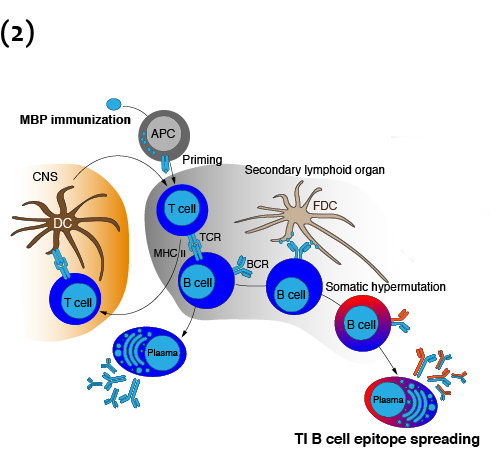
Экспериментально подтверждена гипотеза молекулярной мимикрии как одного из вариантов развития рассеянного склероза. Доказана возможность индукции миелин-реактивных антител путем введения вирусного антигена in vivo (Lomakin et al., Front. Immunol., 2017).
- 2017 Exposure to the Epstein-Barr viral antigen latent membrane protein 1 induces myelin-reactive antibodies in vivo. Front Immunol 8 (0) 777
Лаборатория биокатализа (Габибов А.Г.)
Подходы к индукции толерантности инкапсулированными фрагментами аутоантигенов
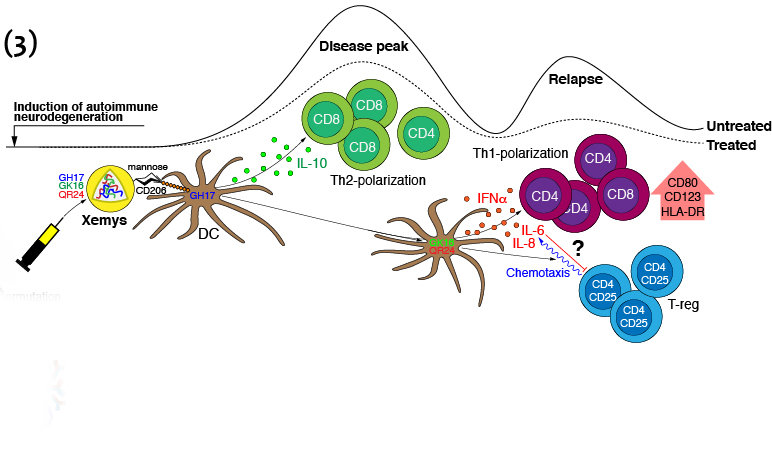
Разработаны подходы к индукции толерантности инкапсулированными фрагментами аутоантигенов. Предложенный на их основе препарат Ксемис успешно прошел I и II фазы клинических испытаний с имеющимся одобренным синопсисом на фазу III. Показан молекулярный механизм его действия, включающий в себя двухфазное подавление аутоиммунной нейродегенрации, опосредованное выбросом противовоспалительных цитокинов на первом этапе и индукции регуляторных Т-клеток на втором (Ivanova et al., Front.Immunol., 2017).
- 2017 Divergent immunomodulation capacity of individual myelin peptides-components of liposomal therapeutic against multiple sclerosis. Front Immunol 8 (0) 1335
Лаборатория клеточной биологии рецепторов (Петренко А.Г.)
,Группа молекулярной физиологии (Деев И.Е.)
Щелочной рН индуцирует IRR-опосредованное фосфорилирование IRS-1 и изменению актинового цитоскелета в линии бета-клеток поджелудочной железы
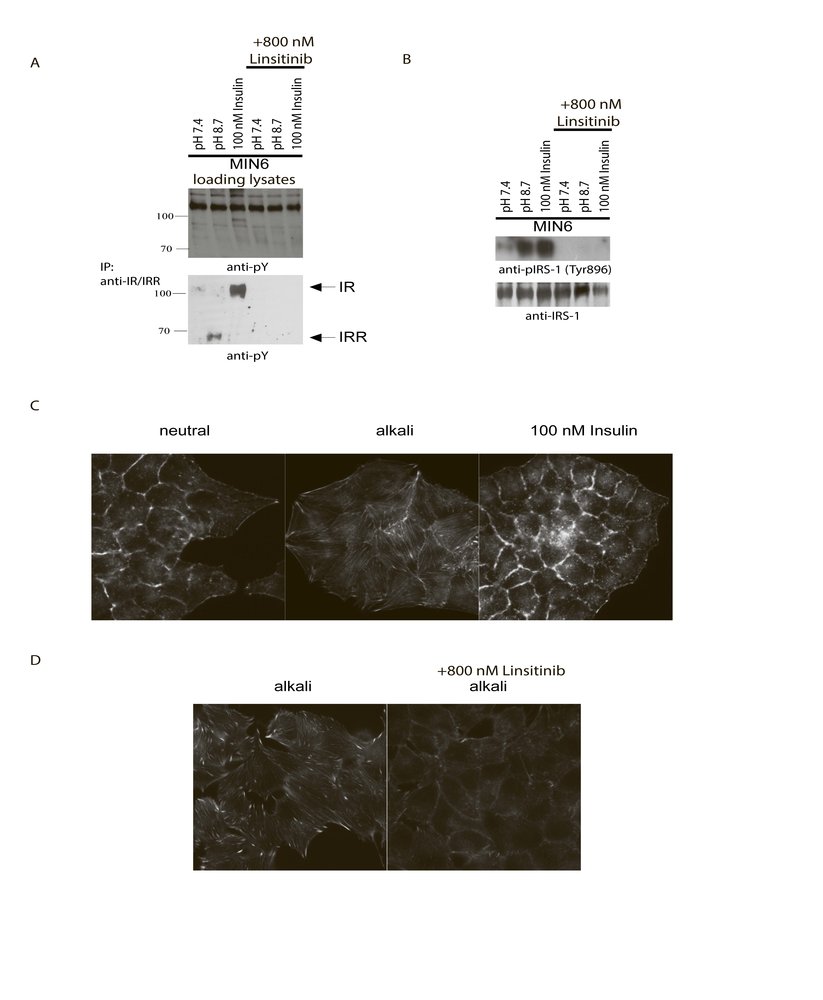
Секреция слабощелочного (рН 8,0-8,5) сока в кишечник является одной из ключевых функций поджелудочной железы. Известно, что система поджелудочной железы, содержащая щелочной сок, может соприкасаться с эндокринными клетками островков поджелудочной железы. Ранее мы идентифицировали рецептор IRR, который экспрессируется в островках Лангерганса в качестве сенсора слабощелочного внеклеточного рН. В этом исследовании мы проанализировали влияние щелочной среды на линию бета-клеток поджелудочной железы MIN6. Была обнаружена активация эндогенного IRR, но не рецептора инсулина, которая может быть ингибирована с помощью ингибитора linsitinib. Автофосфорилирование IRR также приводило к фосфорилированию субстрата 1 рецептора инсулина (IRS-1), основного адаптера в сигнальном пути инсулина, и также блокировалось ингибитором linsitinib. Однако, в отличие от стимуляции инсулина, в результате щелочной обработки не было обнаружено фосфорилирования белка киназы B (Akt / PKB). Мы также наблюдали повышение экспрессии нескольких генов раннего ответа (EGR2, IER2, FOSB, EGR1 и NPAS4) при щелочной обработке клеток MIN6. Щелочная среда, но не инсулин, также вызывала ремоделирование актинового цитоскелета, которое блокировалось предварительной инкубацией с ингибитором linsitinib. Мы предлагаем, чтобы активация IRR щелочью могла быть частью локальной петли сигнализации между экзокринной и эндокринной частями поджелудочной железы.
- 2017 Alkaline pH induces IRR-mediated phosphorylation of IRS-1 and actin cytoskeleton remodeling in a pancreatic beta cell line. B SOC CHIM BIOL 138 (0) 62–69
Лаборатория белков гормональной регуляции (Липкин В.М.)
Показано, что пептид HLDF-6 обладает нейропротекторной активностью на дабл-трансгенной модели болезни Альцгеймера.
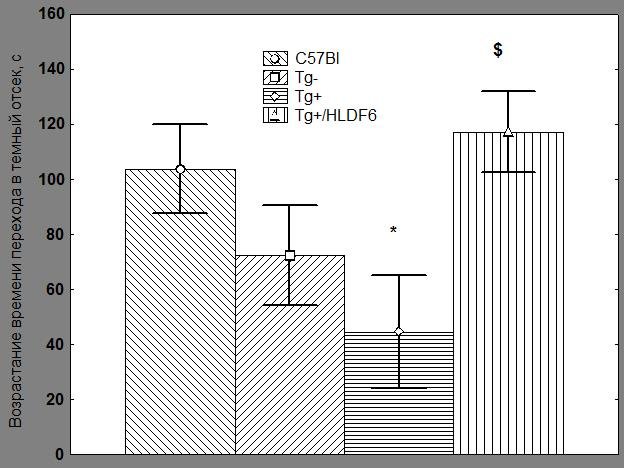
Изучены нейропротекторная и ноотропная активности амидной формы (АФ) пептида HLDF-6 (TGENНR-NH2) на дабл-трансгенных мышах линии B6C3-Tg(APPswe,PSEN1de9)85Dbo (Tg+) – животной модели наследственной болезни Альцгеймера. Характерной особенностью этой линии является раннее развитие патологии альцгеймеровского типа, обусловленное ускоренным отложением в мозге бета-амилоидных образований и нарушением когнитивных функций. Когнитивные способности мышей этой линии не охарактеризованы в достаточной мере. В связи с этим для оценки обоснованности экспериментальных протоколов была введена группа дополнительного контроля.
Лаборатория рентгеноструктурных исследований биополимеров (Плетнёв В.З.)
Пространственная организации и структурно-функциональная взаимосвязь флуоресцентных белков
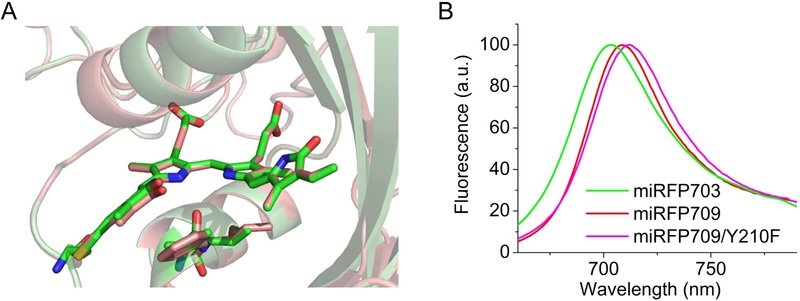
Подпись к рисунку: A) Совмещенные структуры флуоресцентных белков ближнего инфракрасного диапазона – miRFP703 (показан зеленым цветом) and miRFP709 (розовым) с хромофором в центре в связывающей полости. (B) Спектры эмиссии miRFP703 (показан зеленым цветом), miRFP709 (красным), miRFP709/Y210F (розовым)
Методом рентгеноструктурного анализа установлены пространственные структуры и изучена структурно-функциональная взаимосвязь трех новых ярких генно-инженерных биомаркеров (на основе растительных фоторецепторов - фитохромов) дальне-красного и ближнего инфракрасного диапазонов, обеспечивающих высокую проницаемость излучения через биологические ткани - miRFP670 (lэм ~670нм), miRFP703 (703нм) and miRFP709 (709 нм) с разрешением 1.33, 1.35 и 1.34Å, соответственно.
- 2017 Designing brighter near-infrared fluorescent proteins: Insights from structural and biochemical studies. Chem Sci 8 (6) 4546–4557
Группа молекулярной физиологии (Деев И.Е.)
,Лаборатория клеточной биологии рецепторов (Петренко А.Г.)
Сайт-направленный мутагенез в фибронектиновых повторах в рецепторе IRR
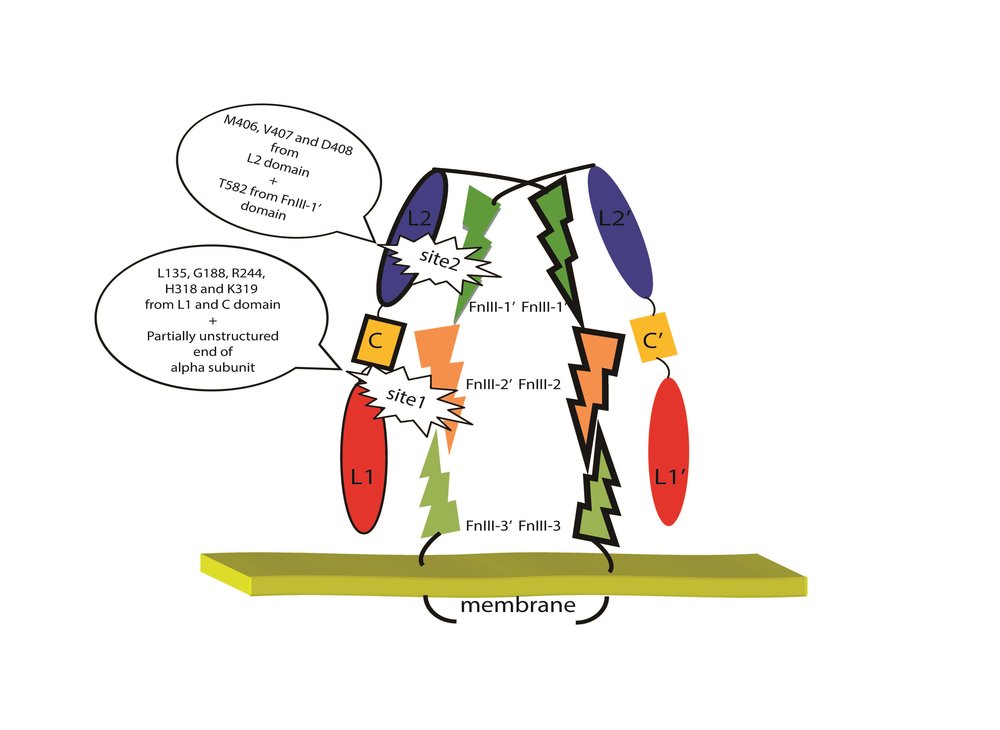
Ранее мы продемонстрировали, что активация IRR определяется его внеклеточной областью, включает в себя несколько доменов и показывает положительную кооперативность с двумя синергетическими сайтами. Теперь мы рассмотрели роль FnIII повторов в рН-чувствительности IRR с помощью анализа точечных мутантов и химер IRR с рецептором инсулина (IR). Мы показали, что первый сайт активации включает в себя неупорядоченный участок (646-716) в домене FnIII-2 на С-конце IRR-альфа-субъединицы вместе с близко расположенными остатками L135, G188, R244, H318, K319 доменов L1 и C второй субъединицы. Второй сайт включает в себя остаток T582 домена FnIII-1 в верхней части пирамиды лямбда-формы IRR вместе с M406, V407, D408 из домена L2 во второй субъединице. Также была оценена возможная важность гликозилирования IRR для его активации. Обычно IRR менее гликозилирован, чем IR и IGF-IR. Замена доменов FnIII-2 и FnIII-3 в IRR на гомологичные домены из IR приводит к сдвигу массы β-субъединицы с 68 кДа для IRR до примерно 100 кДа из-за увеличения гликозилирования и отсутствию рН-чувствительность у этой химеры. Однако мутации четырех аспарагиновых остатков (сайтов гликозилирования в этой химере) приводили к уменьшению гликозилирования химер и к частичному восстановлению рН-чувствительности. Таким образом, мы предполагаем, что обширное гликозилирование FnIII-2 / 3 доменов обеспечивает стерическое препятствие для щелочной активации эктодомена IRR.
- 2017 Site-directed mutagenesis of the fibronectin domains in insulin receptor-related receptor. Int J Mol Sci 18 (11)
Отдел иммунологии
Лаборатория молекулярной иммунологии (Деев С.М.)
Золотые гибридные наночастицы для фототермической терапии рака.
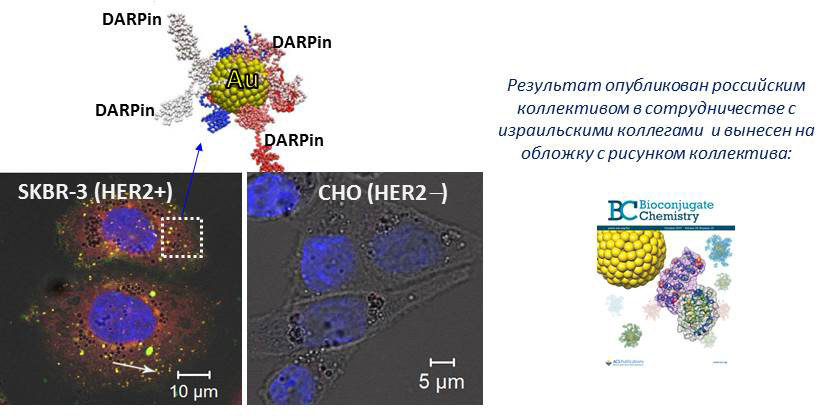
Сконструированы новые агенты для тераностики рака на основе гибридных наночастиц с различным механизмом действия. Наибольший интерес в качестве перспективных агентов для фототермической терапии рака представляют 5 нм наночастицы коллоидного золота, конъюгированные с HER2-специфичным адресным полипептидом неиммуноглобулиновой природы DARPin. Золотые наночастицы, покрытые белковой шубой, обладают высокой стабильностью в физиологических условиях, селективно связываются с HER2-положительными раковыми клетками и интернализуются посредством рецептор-опосредованного эндоцитоза.
Работа поддержана грантом РНФ №14-24-00106.
- 2017 Synthesis, Characterization, and Selective Delivery of DARPin-Gold Nanoparticle Conjugates to Cancer Cells. Bioconjug Chem 28 (10) 2569–2574
- 2017 Ultraviolet phototoxicity of upconversion nanoparticles illuminated with near-infrared light. Nanoscale 9 (39) 14921–14928
- 2017 Targeting group i p21-activated kinases to control malignant peripheral nerve sheath tumor growth and metastasis. Oncogene 36 (38) 5421–5431
- 2017 HER2-specific recombinant immunotoxin 4D5scFv-PE40 passes through retrograde trafficking route and forces cells to enter apoptosis. Oncotarget 8 (13) 22048–22058
- 2017 Deep-penetrating photodynamic therapy with KillerRed mediated by upconversion nanoparticles. Acta Biomater 51 (0) 461–470
Лаборатория клеточных взаимодействий (Сапожников А.М.)
Ретровирусная генная трансдукция NK-клеток человека, активированных с помощью фидерных клеток K562, экспрессирующих мембраносвязанный интерлейкин-21
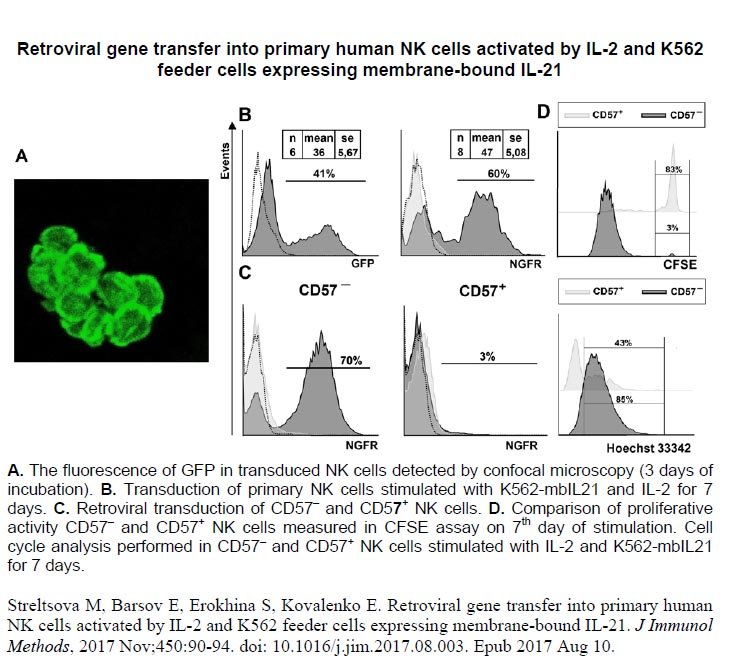
Натуральные киллеры, или NK-клетки, способны быстро распознавать и элиминировать опухолевые клетки, что делает их объектом потенциального терапевтического применения. Генетическая модификация NK-клеток может существенно увеличить их противоопухолевую активность. Однако, этому препятствуют определенные технические проблемы. Нами была осуществлена эффективная трансдукция человеческих NK-клеток ex vivo, активированных комбинацией IL-2 и облученных фидерных клеток K562, экспрессирующих на своей поверхности IL-21. Активированные NK-клетки экспрессировали активирующие рецепторы NKG2D, NKp30, CD16 и были высокопозитивны по HLA-DR. Полученная клеточная субпопуляция оказалась чувствительной к трансдукции с помощью ретровирусных векторов экспрессирующих как GFP, так и NGFR. Субпопуляция более зрелых CD57+ NK-клеток была в целом более устойчивой к ретровирусной трансдукции из-за слабой пролиферативной активности в ответ на данную стимуляцию. Полученные результаты могут быть использованы для дальнейшей работы по генетической инженерии NK-клеток с целью их потенциального противоопухолевого применения.
- 2017 Retroviral gene transfer into primary human NK cells activated by IL-2 and K562 feeder cells expressing membrane-bound IL-21. Immunotechnology 450 (0) 90–94
Лаборатория клеточных взаимодействий (Сапожников А.М.)
Этанол влияет на экспрессию стресс-индуцируемых белков MICA/B
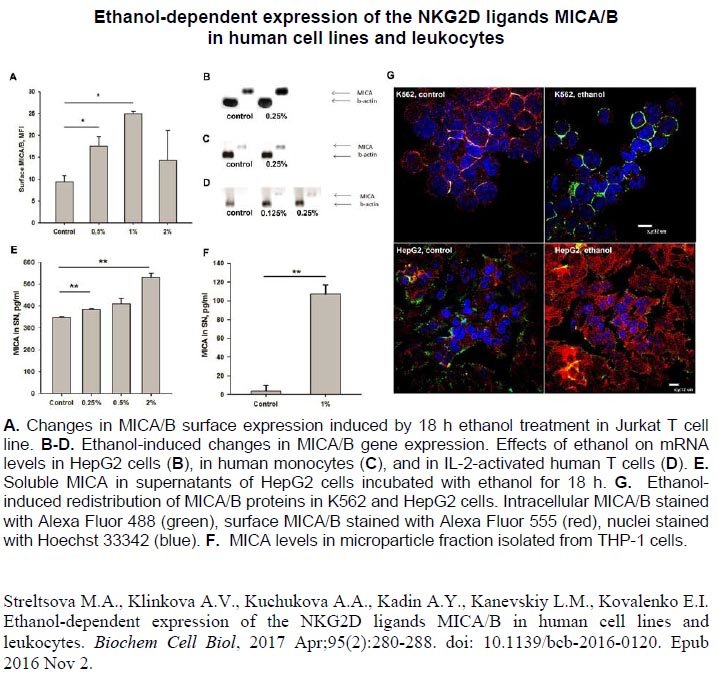
Стресс-индуцируемые белки MICA и MICB осуществляют регуляцию цитотоксических лимфоцитов за счет взаимодействия с экспрессирумым этими клетками рецептором NKG2D. В мембраносвязанной форме белки MICA/B вызывают, как правило, активацию лимфоцитов, тогда как внеклеточные варианты MICA/B, часто выявляемые в сыворотке крови опухолевых больных, приводят к ингибированию их активности. Нами показано, что обработка клеток этанолом, в том числе в физиологических дозах, вызывает высвобождение MICA/B, как в растворимой форме, так и в составе микрочастиц, а также перераспределение внутриклеточного пула с перемещением внутриклеточных белков MICA/B на плазматическую мембрану. Другим важным аспектом действия этанола на клеточные линии и лейкоциты человеческой крови является индукция экспрессии генов и синтезе белков MICA/B. Изменения в экспрессии белков MICA/B, индуцированные этанолом, могут приводить к изменениям в функционировании NKG2D-позитивных лимфоцитов и, как следствие, других иммунных реакций при потреблении алкоголя.
- 2017 Ethanol-dependent expression of the NKG2D ligands MICA/B in human cell lines and leukocytes. Can J Biochem Cell Biol 95 (2) 280–288
- 2016 Циркулирующий белок MICА у больных злокачественными лимфомами. 18 (2) 151–162
Лаборатория молекулярной тераностики (Мартынов В.И.)
,Группа экспрессии белковых факторов роста и дифференцировки (Фролова Е.И.)
,Группа молекулярной физиологии (Деев И.Е.)
Флуорогенный маркер для моментального окрашивания и визуализации мембран живых клеток

На основе органического соединения создан новый флуорогенный маркер для окрашивания мембран живых клеток. В отличие от существующих в настоящее время коммерческих клеточных маркеров, полученный флуорогенный маркер не флуоресцирует в водной среде, а приобретает флуоресценцию только при помещении его в неполярную среду, например, в клеточную мембрану. Это свойство позволяет моментально окрашивать клетки без последующей отмывки от несвязавшейся метки. Этот маркер может быть использован для визуализация живых клеток с помощью флуоресцентной микроскопии и в проточной цитометрии.
- 2017 BODIPY-based dye for no-wash live-cell staining and imaging. Biotechniques 63 (2) 77–79
Отдел структурной биологии
Лаборатория биомолекулярной ЯМР-спектроскопии (Арсеньев А.С.)
,Лаборатория моделирования биомолекулярных систем (Ефремов Р.Г.)
Впервые построена полноразмерная модель рецептора TLR4
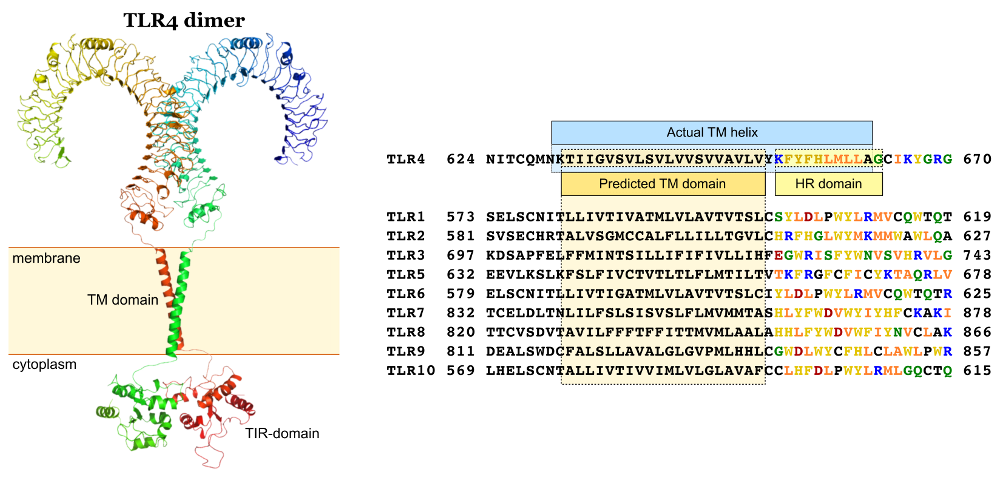
Были получены структуры трансмембранной и примембранной частей рецептора TLR4 с использованием спектроскопии ЯМР в различных мембранных окружениях, в том числе фосфолипидных бицеллах. Показано, что примембранная область TLR4 является частью длинной трансмембранной α-спирали. Был найден интерфейс димеризации TM-домена и показано, что такие длинные TM-домены с заряженными аминокислотами - это общая черта всех белков семейства TLR, что позволяет по-другому взглянуть на механизм активации рецепторов TLR. Наконец, была предложена модель полноразмерного рецептора TLR4 в димерном состоянии на основе структур отдельно взятых доменов.
- 2017 Spatial structure of TLR4 transmembrane domain in bicelles provides the insight into the receptor activation mechanism. Sci Rep 7 (1) 6864
Лаборатория моделирования биомолекулярных систем (Ефремов Р.Г.)
,Лаборатория биомолекулярной ЯМР-спектроскопии (Арсеньев А.С.)
,Лаборатория молекулярной токсинологии (Уткин Ю.Н.)
Структурно-динамическая модель взаимодействия цитотоксина S-типа с мицеллами детергентов и липидными мембранами: спектроскопия ЯМР высокого разрешения и молекулярная динамика.
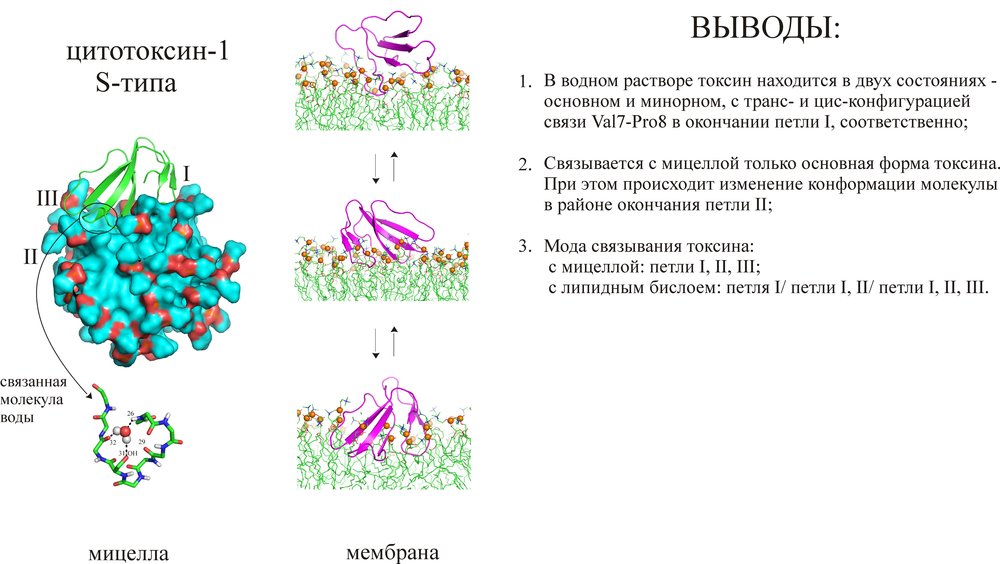
Расшифровка пространственной структуры мембранных пептидов и белков методами спектроскопии ЯМР высокого разрешения предполагает использование сред, моделирующих мембранное окружение. Чаще всего в экспериментах используют мицеллы детергентов. Однако неясно, как перенести результаты таких исследований на липидный бислой. В настоящей работе предложен ответ на этот вопрос для бета-структурного белка, цитотоксина 1 S-типа, выделенного из яда кобры N. oxiana. Пространственная структура белка получена методом спектроскопии ЯМР в водном растворе и в мицеллах додецилфосфохолина (ДФХ). Методами молекулярной динамики (МД) в полноатомном и «крупнозернистом» (coarse-grained) приближениях исследовали встраивание белка в мицеллы ДФХ (Рисунок, левая панель) и в липидный бислой пальмитоилолеоилфосфатидилхолина (Рисунок, правая панель). Показано, что встраивание токсина как в мицеллы, так и в мембраны сопровождается адаптацией молекулы белка к гидрофобно/ гидрофильной среде и конформационной перестройкой в районе окончания петли-II (Рисунок, левая панель). При этом в мицелле реализуется только одно связанное состояние молекулы токсина – окончаниями всех трёх петель молекулы. В бислое наблюдается усреднение между тремя модами связывания – окончаниями первой петли; окончаниями петель I и II; окончаниями всех трёх петель (Рисунок, правая панель, сверху-вниз).
- 2017 Impact of membrane partitioning on the spatial structure of an S-type cobra cytotoxin. J Biomol Struct Dyn (0) 1–16
Лаборатория моделирования биомолекулярных систем (Ефремов Р.Г.)
,Лаборатория биомолекулярной ЯМР-спектроскопии (Арсеньев А.С.)
Активация рецепторных тирозинкиназ сопровождается изменением структурно-динамических параметров липидного бислоя мембраны вблизи белка

Для детализации и визуализации предложенного авторами в 2014-2016 гг. оригинального липид-опосредованного механизма активации рецепторных тирозинкиназ (РТК) разработана вычислительная методика картирования динамических белок-липидных контактов на поверхности трансмембранных спиралей, а также способ учета изменения конфигурационной энтропии липидных молекул вследствие возмущений, вызванных в липидном бислое альфа-спиральными димерами белков в разных конформационных состояниях. Методика апробирована в ходе анализа длительных траекторий молекулярной динамики, рассчитанных для различных состояний трансмембранных димеров РТК в бислое ПОФХ – рецепторов PDGFRa и EGFR. Показано, что конформации, соответствующие активному состоянию димеризованного рецептора, оказывают более выраженное возмущение липидного бислоя по сравнению с неактивными.
- 2017 The Conformation of the Epidermal Growth Factor Receptor Transmembrane Domain Dimer Dynamically Adapts to the Local Membrane Environment. Biochemistry 56 (12) 1697–1705
Лаборатория моделирования биомолекулярных систем (Ефремов Р.Г.)
Локальные конформационные изменения в молекулах цитотоксинов влияют на механизм их взаимодействия с мембранами
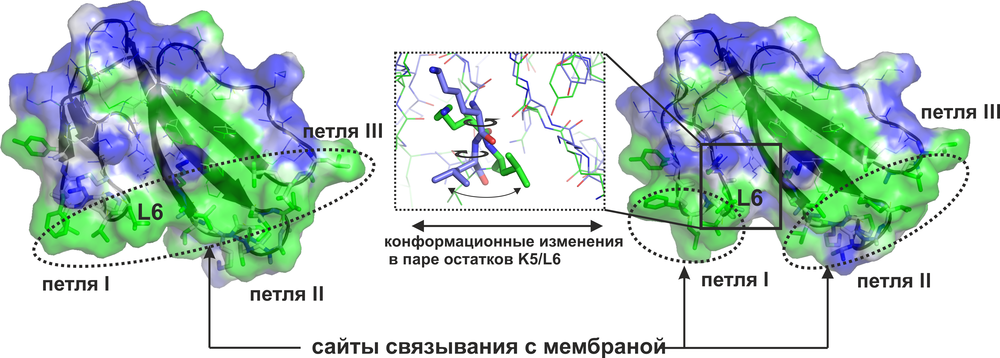
Локальная конформационная подвижность жестко структурированных и стабильных молекул цитотоксинов (ЦТ) оказывает влияние на их мембрано-активные свойства. На основании данных молекулярной динамики (МД) трех ЦТ (ЦТ 1, 2 из Naja oxiana и ЦТ А3 из Naja atra) в воде и анализа распределений значений двугранных углов аминокислотных остатков основной цепи выявили общие для исследуемых белков конформационные состояния, характеризующиеся высокоамплитудными изменениями двугранных углов φ и ψ в паре остатков (K5/L6). Указанные локальные конформационные изменения ЦТ являются специфическими «горячими точками», меняющими организацию функционально-активного гидрофобного паттерна (т.н. «гидрофобной подошвы») этих белков. Именно этот мотив отвечает за связывание ЦТ с клеточными мембранами. В ходе МД «подошва» может обратимо разделяться на два участка меньших размеров (Рисунок). Таким образом молекулы ЦТ осуществляют «тонкую подстройку» своей пространственной структуры при связывании с поверхностью клеточной мембраны в зависимости от размеров гидрофобных/гидрофильных кластеров на поверхности липидного бислоя.
- 2017 Cardiotoxins: Functional Role of Local Conformational Changes. J Chem Inf Model 57 (11) 2799–2810
Лаборатория моделирования биомолекулярных систем (Ефремов Р.Г.)
Формирование пор в липидных мембранах: построение теории на основе молекулярного моделирования и экспериментальных данных
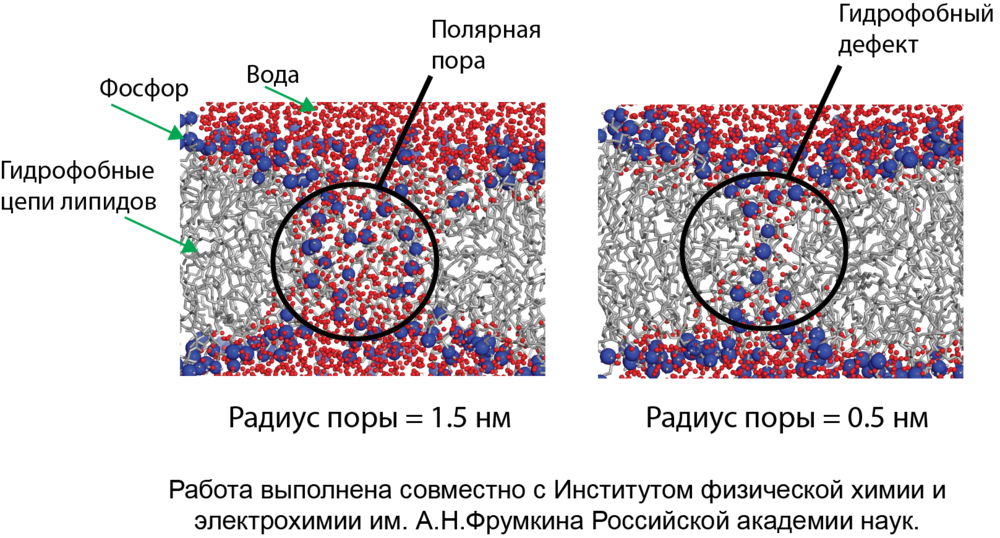
Перенос веществ через липидную мембрану может происходить с образованием пор. Атомистические детали структурных перестроек, возникающих в липидном бислое мембран при формировании пор, до сих пор не понятны. В работе исследовали зависимость времени жизни мембранных пленок из различных липидов от приложенного электрического напряжения. Кроме того, с помощью расчетов молекулярной динамики (МД) изучен процесс затягивания предварительно сформированной поры в бислое. Анализ полученных данных позволил усовершенствовать современную теорию, описывающую энергетические аспекты возникновения пор в липидной мембране. На основании результатов МД сделано предположение о том, что возникновение поры сопряжено с формированием гидрофобного дефекта в мембране при малых радиусах поры. При переходе от состояния системы с гидрофобной поверхностью поры к состоянию с гидрофильной поверхностью необходимо преодолеть энергетический барьер. Сделан вывод о том, что при изменении радиуса поры линейное натяжение в бислое на границе поры зависит от ее радиуса. Предложенная теория хорошо согласуется с экспериментальными данными.
- 2017 Pore formation in lipid membrane II: Energy landscape under external stress. Sci Rep 7 (1) 12509
- 2017 Pore formation in lipid membrane I: Continuous reversible trajectory from intact bilayer through hydrophobic defect to transversal pore. Sci Rep 7 (1) 12152
Лаборатория оптической микроскопии и спектроскопии биомолекул (Феофанов А.В.)
Механизмы интернализации и особенности внутриклеточного распределения магнитных наночастиц, функционализированных фолиевой кислотой
А.А. Игнатова, А.В. Феофанов
Ориентированные на тераностику флуоресцентно-меченые наночастицы оксида железа, покрытые полиэтиленгликолем и функционализированные фолиевой кислотой, эффективно накапливаются в клетках карциномы шейки матки HeLa с высоким уровнем мембранных фолатных рецепторов.
Проникновение наночастиц в клетки HeLa происходит преимущественно путем клатрин-зависимого эндоцитоза при слабом участии кавеолин-опосредованного эндоцитоза и завершается их концентрированием в лизосомах.
Работа выполнена в сотрудничестве с А.Шибановой (Биологический факультет МГУ им. М.В.Ломоносова), E. Allard-Vannier, K. Hervé-Aubert, K. Kaaki, T. Blondy, M.L. Saboungi, I. Chourpa (EA 6295 Nanomédicaments et Nanosondes, Université F. Rabelais de Tours, Tours, France).
- 2017 Folic acid-capped PEGylated magnetic nanoparticles enter cancer cells mostly via clathrin-dependent endocytosis. BIOCHIM BIOPHYS ACTA 1861 (6) 1578–1586
Лаборатория оптической микроскопии и спектроскопии биомолекул (Феофанов А.В.)
,Группа нанобиоинженерии (Некрасова О.В.)
РАЗРАБОТКА ЭФФЕКТИВНОГО МЕТОДА ПОЛУЧЕНИЯ РЕКОМБИНАНТНЫХ ПЕПТИДОВ α-KTX – БЛОКАТОРОВ КАЛИЕВЫХ КАНАЛОВ
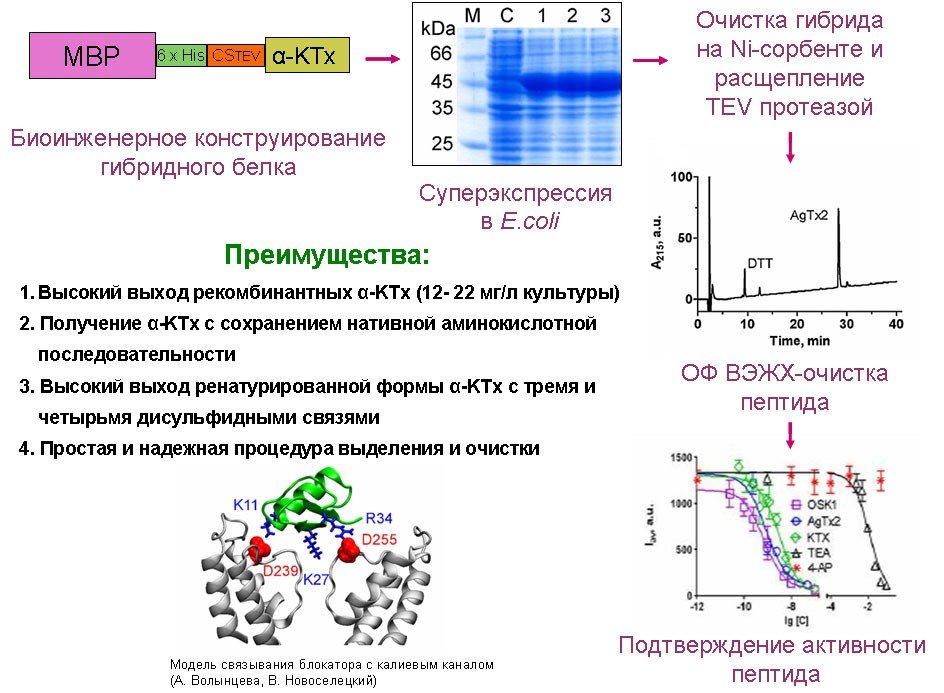
О.В.Некрасова, К.С. Кудряшова, С.А. Якимов, М.П.Кирпичников
А.В.Феофанов
Разработан биоинженерный метод получения пептидных блокаторов калиевых Kv1-каналов, который отличается:
- высоким выходом целевых пептидов (12-22 мг/л культуры);
- сохранением нативной аминокислотной последовательности пептидов;
- высоким выходом ренатурированной формы пептидов с правильно замкнутыми тремя и четырьмя дисульфидными связями;
- простой и надежной процедурой выделения и очистки.
Получаемые этим методом рекомбинантные пептиды семейства α-КТх обладают активностью исходных природных блокаторов. Пептидные высокоаффинные блокаторы калиевых каналов из яда скорпионов широко используются для изучения структуры и функции каналов и имеют перспективное медицинское значение.
- 2017 Recombinant scorpion toxins: Focus on four-disulfide peptide blockers of Kv1-channels. Bioengineered 9 (1) 25–29
- 2017 Straightforward approach to produce recombinant scorpion toxins—Pore blockers of potassium channels. J Biotechnol 241 (0) 127–135
Группа структурной биологии ионных каналов (Шенкарёв З.О.)
,Лаборатория биомолекулярной ЯМР-спектроскопии (Арсеньев А.С.)
,Лаборатория моделирования биомолекулярных систем (Ефремов Р.Г.)
,Группа биоинженерии нейромодуляторов и нейрорецепторов (Люкманова Е.Н.)
Вторичная структура и динамика потенциалочувствительного домена второй псевдосубъединицы канала Nav1.4 скелетных мышц человека
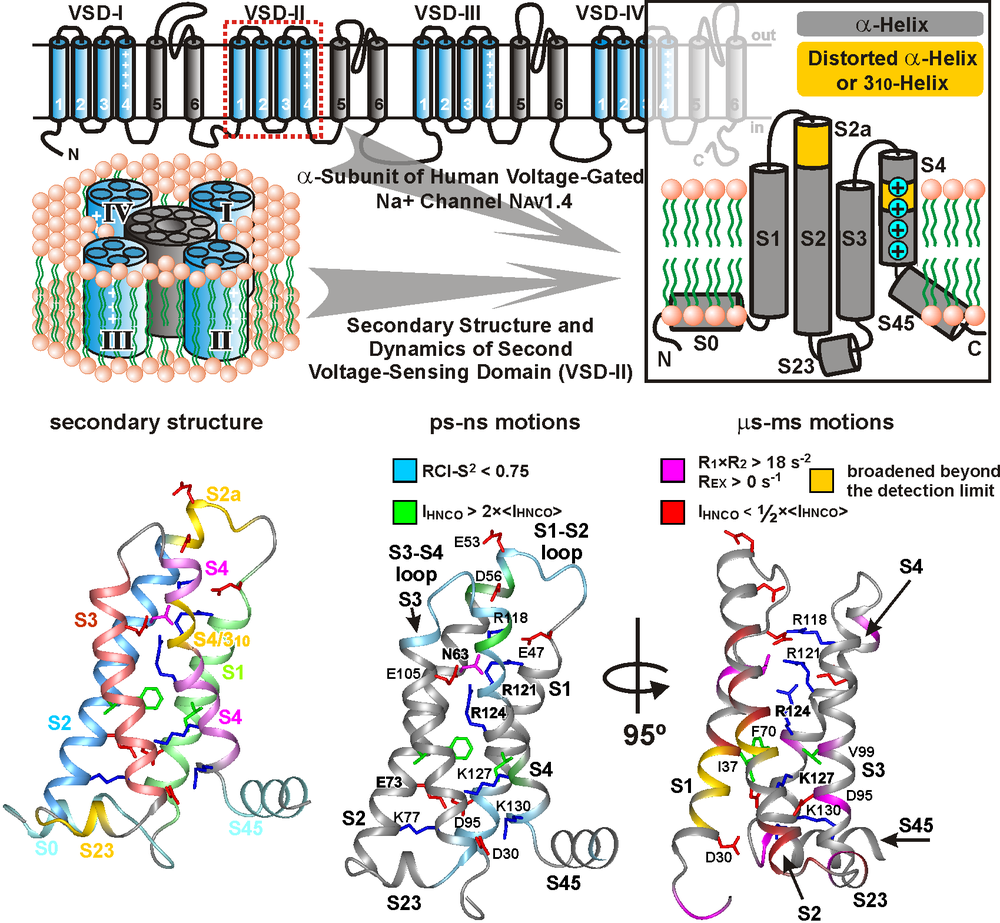
Потенциалозависимые Na+ каналы играют важнейшую роль в функционировании сердечно-сосудистой, мышечной и нервной систем. α-субъединица Na+ канала состоит из ~2000 аминокислотных остатков, что значительно затрудняет структурные исследования полноразмерных каналов. Методом ЯМР-спектроскопии мембраномоделирующем окружении, был исследован изолированный потенциалочувствительный домен (VSD-II) канала Nav1.4 скелетных мышц человека. Вторичная структура VSD-II схожа со структурой бактериальных Na+ каналов. Часть спирали S4 между первым и вторым консервативными остатками Arg, вероятно, имеет конформацию 3/10-спирали. Данные о релаксации ядер 15N выявили характерную подвижность в мкс-мс временном диапазоне для участков VSD-II, участвующих в предполагаемых межспиральных контактах. VSD-II демонстрирует повышенную подвижность в пс-нс временном диапазоне по сравнению с изолированными VSD K+ каналов.
- 2017 NMR investigation of the isolated second voltage-sensing domain of human Nav1.4 channel. BIOCHIM BIOPHYS ACTA 1859 (3) 1–33
- 2017 ПОДХОД “РАЗДЕЛЯЙ И ВЛАСТВУЙ” ДЛЯ СТРУКТУРНЫХ ИССЛЕДОВАНИЙ МУЛЬТИДОМЕННЫХ ИОННЫХ КАНАЛОВ НА ПРИМЕРЕ ИЗОЛИРОВАННЫХ ПОТЕНЦИАЛ-ЧУВСТВИТЕЛЬНЫХ ДОМЕНОВ КАНАЛОВ Kv2.1 И Nav1.4 ЧЕЛОВЕКА1. 43 (6) 608–619
Отдел геномики и постгеномных технологий
Лаборатория структуры и функций генов человека (Свердлов Е.Д.)
Новый подход к созданию раково-специфичных промоторов. Получение и анализ комбинаторной библиотеки химерных промоторов, состоящих из случайных комбинаций промоторных модулей.
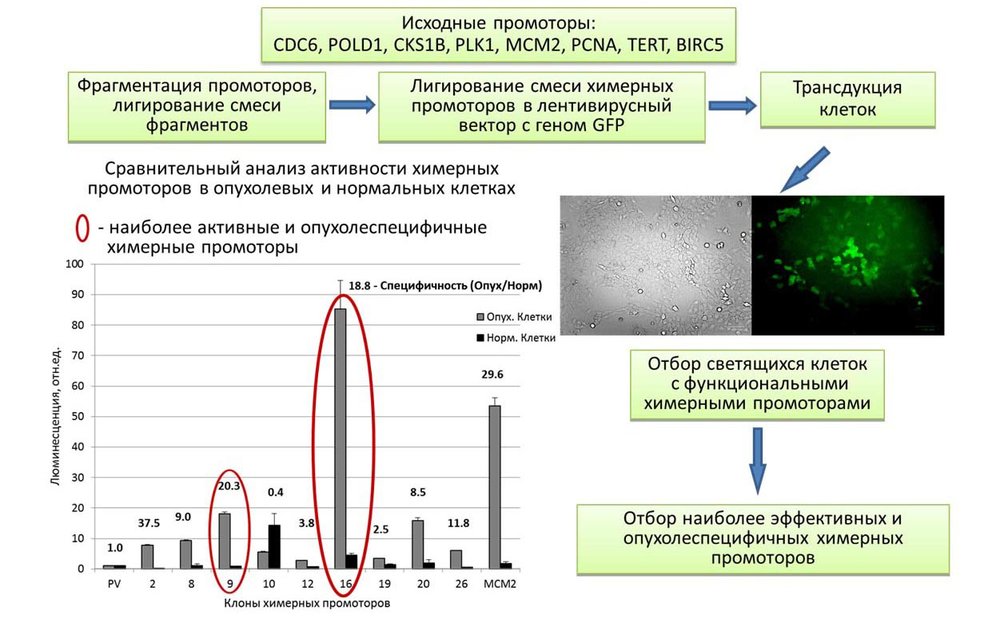
Исследование промоторов транскрипции, активных в раковых клетках и неактивных в нормальных, важно для понимания процессов канцеро- и эмбриогенеза. Выявление или создание высокоспецифичных «раковых» промоторов также имеет большой практический интерес для создания конструкций, ограниченных в своем токсическом действии опухолями и не затрагивающих здоровые ткани в противоопухолевой генной терапии. В продолжение предыдущих работ (Alekseenko et al, 2012; Kashkin et al, 2015) для поиска новых промоторов с заданными функциями впервые создана и проанализирована библиотека химерных промоторов путём случайного комбинирования фрагментов раково-специфичных промоторов генов человека. Библиотеку химерных промоторов встраивали в лентивирусный вектор с репортерным геном CopGFP и трансдуцировали клетки A431, после чего отбирали светящиеся клетки, содержащие активные химерные промоторы. Показано, что большая доля отобранных клеток содержит активные раково-специфичные промоторы. Анализ случайно выбранных клонов показал неслучайные сочетания фрагментов в химерных промоторах. Некоторые из химер проявляют высокую промоторную активность и раковую специфичность. Дальнейший анализ наиболее часто встречающихся модулей в раково-специфичных химерах может расширить представление о природе раково-специфической промоторной активности и позволить направленно создавать более активные и специфичные промоторы.
- 2017 Construction of a combinatorial library of chimeric tumor-specific promoters. Biotechniques 63 (3) 107–116
- 2015 Cancer specificity of promoters of the genes controlling cell proliferation. J Supramol Struct Cell Biochem 116 (2) 299–309
- 2012 Activity of the Upstream Component of Tandem TERT/Survivin Promoters Depends on Features of the Downstream Component. PLoS One 7 (10) e46474
Лаборатория биофотоники (Лукьянов К.А.)
,Лаборатория химии метаболических путей (Ямпольский И.В.)
,Группа химии гетероциклических соединений (Баранов М.С.)
Метод флуоресцентного мечения белков в живых клетках на основе флуорогена и флуороген-связывающего белка
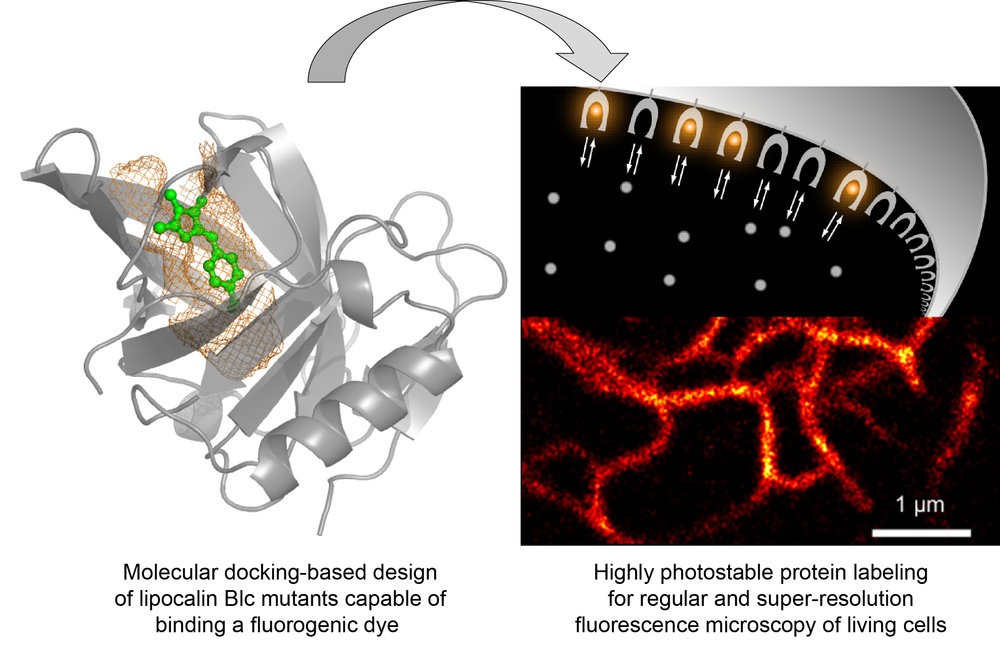
Мы разработали новый метод мечения целевых белков в живой клетке, названный Protein-PAINT. Метод основан на обратимом связывании белкового домена с флуорогенным красителем, что приводит к многократному увеличению интенсивности его флуоресценции. На основе результатов компьютерного молекулярного докинга, мы получили три мутантных варианта бактериального липокалина Blc с различным сродством к флуорогену. Было показано, что флуороген быстро проникает в живые клетки и вызывает окрашивание целевых белков, слитых с мутантными Blc. Новый метод обеспечивает на порядок большую фотостабильность сигнала, по сравнению с флуоресцентными белками. Protein-PAINT также позволяет проводить долговременную флуоресцентную микроскопию сверхвысокого разрешения живых клеток как в режиме детекции одиночных молекул, так и в режиме STED.
- 2017 Protein labeling for live cell fluorescence microscopy with a highly photostable renewable signal. Chem Sci 8 (10) 7138–7142
Группа геномного анализа сигнальных систем клетки (Буздин А.А.)
Новый способ оценки скорости эволюции молекулярных путей

Установлено, что профили посадки транскрипционных факторов вблизи промоторов генов, солокализующиеся с последовательностями генетических мобильных элементов, могут являться маркерами скорости эволюции молекулярных путей. Выявлено, что в предковой линии человека помимо путей, вовлеченных в иммунный ответ и взаимодействие с патогенами, наиболее быстро эволюционировали пути, ответственные за метаболизм жиров, катаболизм гетероциклических соединений и за формирование органов чувств.
Отдел молекулярной нейроиммунной сигнализации
Лаборатория молекулярной токсинологии (Уткин Ю.Н.)
Открыто подавление роста карциномы Эрлиха факторами яда кобры

При исследовании влияния компонентов яда кобры на привитую мышам карциному Эрлиха впервые установлено, что фактор роста нервов (NGF) яда кобры и фактор яда кобры (CVF) подавляют рост опухоли. При этом противоопухолевое действие NGF зависит от статуса иммунной системы и пропадает при истощении системы комплемента; нарушение воспалительного ответа также отменяет противоопухолевый эффект NGF.
- 2017 Cobra venom factor and ketoprofen abolish the antitumor effect of nerve growth factor from cobra venom. Toxins (Basel) 9 (9)
- 2016 Suppression of Ehrlich carcinoma growth by cobra venom factor. Dokl Biol Sci 470 (1) 240–243
- 2014 Nerve growth factor from cobra venom inhibits the growth of Ehrlich tumor in mice. Toxins (Basel) 6 (3) 784–795
Лаборатория лиганд-рецепторных взаимодействий (Кашеверов И.Е.)
,Лаборатория молекулярной токсинологии (Уткин Ю.Н.)
Разработка новой методики на основе кальциевого имиджинга и функциональная характеристика с ее помощью α7/α9 мутантов нАХР.
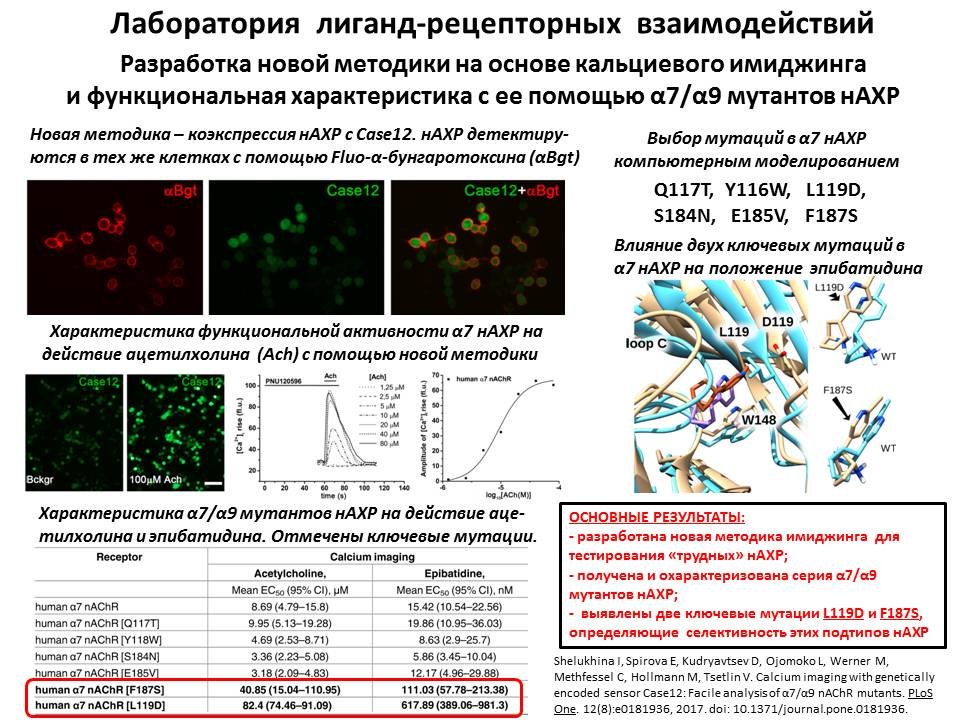
На основании метода кальциевого имиджинга была разработана новая методика, позволяющая достаточно эффективно экспрессировать в клеточных линиях функционально активные «трудные» подтипы никотиновых рецепторов (нАХР). Методика включает в себя коэкспресиию с соответствующим подтипом рецептора шаперона и флуоресцентного кальциевого сенсора Case12. Данная методика позволила получить 6 мутантных форм α7 нАХР с выбранными одиночными заменами аминокислотных остатков из α9 подтипа нАХР. Все полученные мутанты вместе с исходными рецепторами были проанализированы на сродство к ацетилхолину и эпибатидину с помощью разработанной методики. Это позволило выявить две ключевые мутации - L119D и F187S, определяющие селективность к указанным лигандам этих подтипов нАХР. Компьютерное моделирование показало существенное изменение расположение молекул лигандов в участках связывания именно этих двух мутантных форм рецептора, объясняя полученные данные.
- 2017 Calcium imaging with genetically encoded sensor Case12: Facile analysis of α7/α9 nAChR mutants. PLoS One 12 (8) e0181936
Лаборатория лиганд-рецепторных взаимодействий (Кашеверов И.Е.)
,Лаборатория молекулярной токсинологии (Уткин Ю.Н.)
Cинтезирован SLURP-1 (81 аминокислотный остаток, 5 дисульфидов), идентичный по аминокислотной последовательности эндогенному белку человека, отличающийся от всех известных рекомбинантных белков по
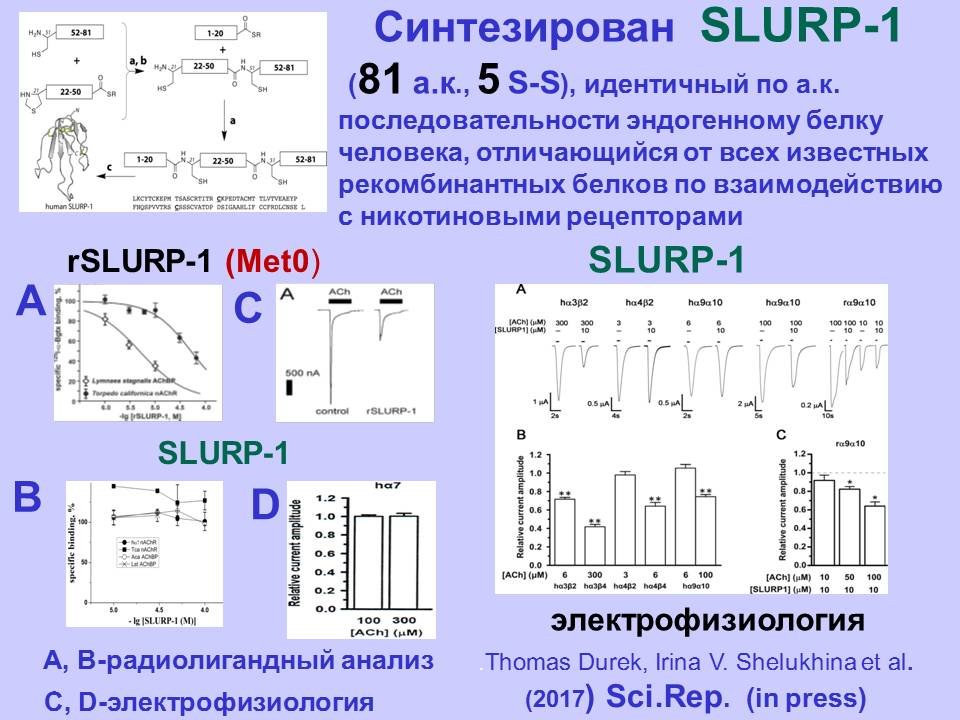
Синтезирован SLURP-1 (81 аминокислотный остаток, 5 дисульфидов), идентичный по аминокислотной последовательности эндогенному токсино-подобному белку человека. По данным 1Н-ЯМР он имеет ту же структуру, что и рекомбинантный rSLURP-1, несущий дополнительный N-концевой Met0, несколько отличается по молекулярной динамике и существенно по биологической активности в отношении различных подтипов никотиновых рецепторов. То есть необходимо максимальное приближение к структуре природного белка для установления механизмов его эндогенной активности и выбора последующих медицинских применений.
- 2017 Interaction of Synthetic Human SLURP-1 with the Nicotinic Acetylcholine Receptors. Sci Rep 7 (1) 16606
Лаборатория оксилипинов (Безуглов В.В.)
Новые флуоресцентные производные ацилдофаминов с сохраненной адресной частью
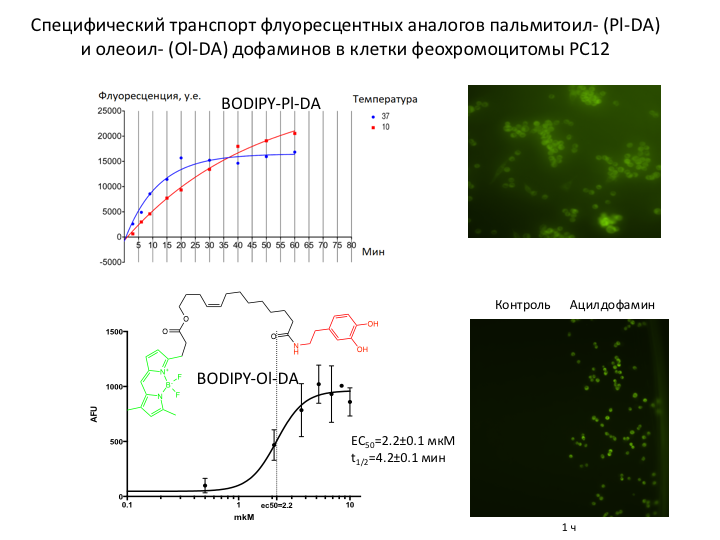
Синтезированы новые флуоресцентные аналоги природных ацилдофаминов, имитирующих остатки пальмитиновой и олеиновой кислот с репортерной группой BODIPY на дистальном конце молекулы. Продемонстрировано специфичное накопление этих веществ в клетках феохромоцитомы крысы PC12 и измерены параметры этого процесса. Скорость накопления олеинового аналога оказалась в три раза выше по сравнению с пальмитиновым аналогом. Данные вещества могут быть использованы для изучения транспорта ацилдофаминов в различных клетках человека и животных.
Отдел биоинженерии
Лаборатория инженерии белка (Долгих Д.А.)
Фрагмент (76)PGTKMIFA(83) лошадиного цитохрома с играет ключевую роль в его электрон-транспортной активности
Исследовано влияние конформации петлевого участка P76GTKMIFA83 лошадиного цитохрома с на электрон-транспортную активность белка. На основе данных анализа информационной структуры получен ряд вариантов цитохрома с с множественными заменами в сайте P76GTKMIFA83, направленными на понижение его конформационной подвижности. Исследованы сукцинат:цитохром с-редуктазная и цитохром с-оксидазная активности митопластов печени крысы в присутствии вариантов цитохрома с. Показано, что способность к переносу электрона мутантных вариантов была снижена в разной степени. Согласно данным спектроскопии резонансного (РКР) и гигантского (ГКР) комбинационного рассеяния снижение электрон-транспортной активности мутантных вариантов коррелирует с конформационными изменениями и уменьшением подвижности гемопорфирина. Полученные результаты свидетельствуют о ключевой роли фрагмента P76GTKMIFA83 в функционировании цитохрома с.
- 2017 New insight into the mechanism of mitochondrial cytochrome c function. PLoS One 12 (5) e0178280
Группа нанобиоинженерии (Некрасова О.В.)
,Лаборатория оптической микроскопии и спектроскопии биомолекул (Феофанов А.В.)
Разработка эффективного метода получения рекомбинантных пептидов α-KTX – блокаторов калиевых каналов

Разработан биоинженерный метод получения пептидных блокаторов калиевых Kv1-каналов, который отличается: высоким выходом целевых пептидов (12-22 мг/л культуры);
сохранением нативной аминокислотной последовательности пептидов; высоким выходом ренатурированной формы пептидов с правильно замкнутыми тремя и четырьмя дисульфидными связями; простой и надежной процедурой выделения и очистки. Получаемые этим методом рекомбинантные пептиды семейства α-КТх обладают активностью исходных природных блокаторов. Пептидные высокоаффинные блокаторы калиевых каналов из яда скорпионов широко используются для изучения структуры и функции каналов и имеют перспективное медицинское значение.
- 2017 Recombinant scorpion toxins: Focus on four-disulfide peptide blockers of Kv1-channels. Bioengineered 9 (1) 25–29
- 2017 Straightforward approach to produce recombinant scorpion toxins—Pore blockers of potassium channels. J Biotechnol 241 (0) 127–135
Отдел молекулярной нейробиологии
Лаборатория нейрорецепторов и нейрорегуляторов (Козлов С.А.)
,Лаборатория биомолекулярной ЯМР-спектроскопии (Арсеньев А.С.)
,Лаборатория лиганд-рецепторных взаимодействий (Кашеверов И.Е.)
Открыты первые пептидные лиганды, потенцирующие ответ TRPA1 рецепторов на агонисты, проявляющие обезболивающий и противовоспалительный эффекты.
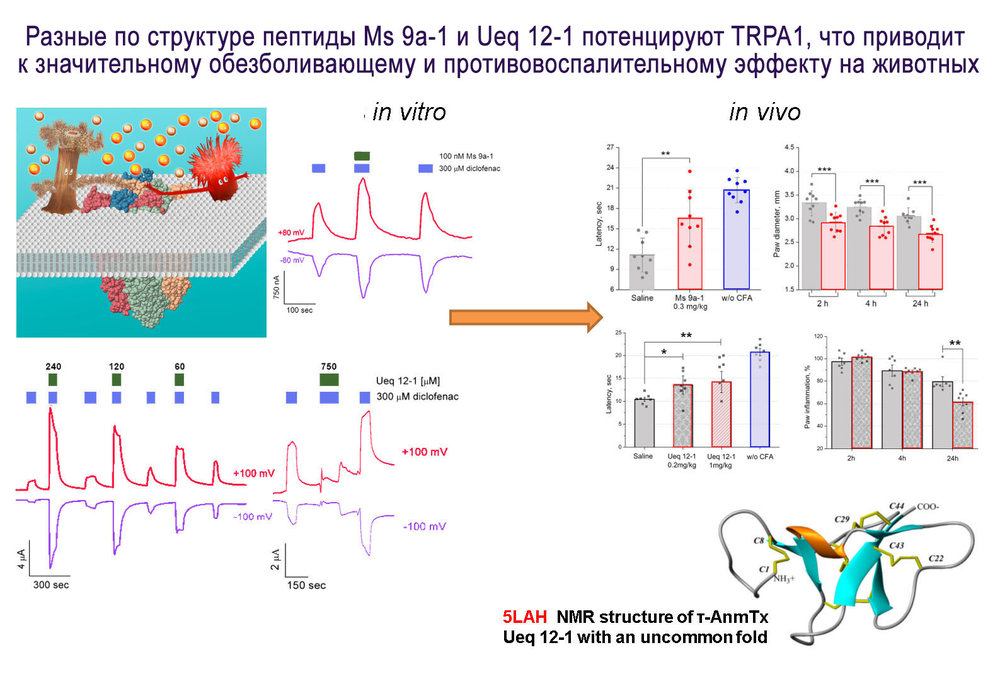
Из морских анемон видов Metridium senile и Urticina eques выделены и охарактеризованы анальгетические пептиды Мs9а-1 и Ueq 12-1. Пептид Мs9а-1 содержит 35 аминокислотных остатков, а его пространственная структура стабилизирована двумя дисульфидными мостиками подобно ранее описанным пептидам из морских анемон. Ueq 12-1 состоит из 45 аминокислотных остатков, включая 10 остатков цистеина с необычным распределением, образующих 5 дисульфидных связей, и является уникальным среди многообразия известных пептидов морских анемон. Являясь по сути принципиально новой обнаруженной пространственной структурой, пространственная укладка части полипептидной цепи молекулы Ueq 12-1 похожа на альфа дефензины млекопитающих. Возможно, именно поэтому пептид также обладает слабым антимикробным действием на грамм-положительные бактерии. Структурно непохожие друг не друга пептиды Мs9а-1 и Ueq 12-1 имеют схожий механизм действия и одну биологическую мишень. В тестах in vitro на ооцитах лягушки Xenopus laevis и клетках млекопитающих, экспрессирующих рецептор TRPA1, оба пептида усиливали действие прямых агонистов, таких как AITC и диклофенак. В тестах in vivo на мышах введение пептидов внутривенно давало значительный анальгетический и противовоспалительный эффект, при этом сами пептиды при введении не вызывали ни болевых ощущений ни тепловую гиперчувствительность. Обнаруженные эффекты пептидов связаны с тем, что при взаимодействии с TRPA1 пептиды делают рецептор более восприимчивым к распознаванию своих агонистов (потенцирующее действие), таким образом, при появлении эндогенных раздражителей, таких как, например, медиаторы воспаления, происходит десенситизация TRPA1-экспрессирующих нейронов. Способность этих веществ избирательно усиливать активность белка TRPA1 открывает новые возможности фундаментальных исследований и служит основой создания лекарств от боли и воспаления.
- 2017 New disulfide-stabilized fold provides sea anemone peptide to exhibit both antimicrobial and TRPA1 potentiating properties. Toxins (Basel) 9 (5)
- 2017 Peptide from sea anemone metridium senile affects transient receptor potential ankyrin-repeat 1 (TRPA1) function and produces analgesic effect. J Biol Chem 292 (7) 2992–3004
Лаборатория нейрорецепторов и нейрорегуляторов (Козлов С.А.)
Впервые охарактеризованы эндогенные лиганды рецептора ASIC3, способные активировать канал без участия протонов, а также выводить ASIC3 человека из состояния десенситизации при физиологических значениях pH.
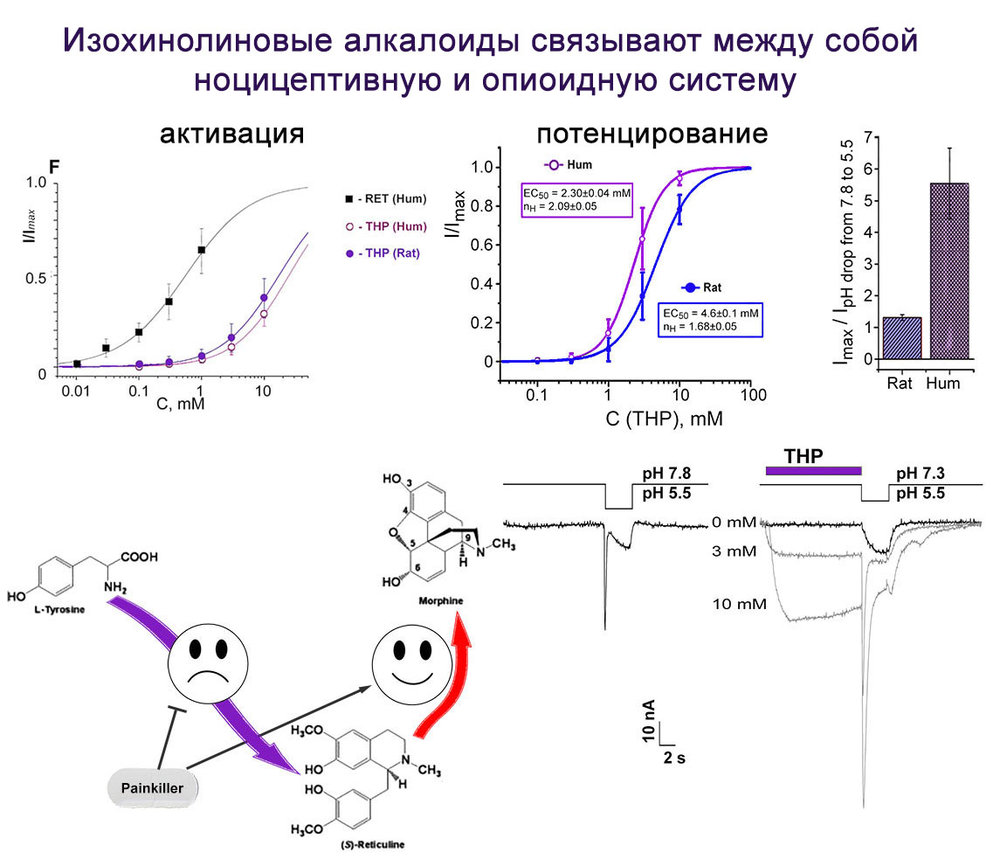
Найдены первые активаторы кислото-чувствительных каналов ASIC, обладающие уникальным, ранее не описанным механизмом действия. Изохинолиновые алкалоиды (THP, ретикулин), которые синтезируются клетками млекопитающих как промежуточные продукты в цикле синтеза эндогенного морфина из тирозина, в милимолярных концентрациях способны возвращать канал ASIC3 из протон-опосредованной десенсибилизации, и одновременно эффективно активировать hASIC3 и rASIC3 при физиологическом рН 7.4 и слабо щелочных условиях. До настоящего момента был описан очень ограниченный набор активаторов ASICs, при чем описанные агонисты главным образом сдвигают активационную способность каналов в область более высоких значений рН, делая рецепторы более чувствительными к меньшим скачкам рН, при этом вклад протонов в процесс открытия каналов рассматривался как основной. Охарактеризованные и зохинолиновые алкалоиды — первые «непротонные» активаторы ASIC3 рецепторов.
При фармакологической характеристике «непротонных» активаторов на изоформы ASIC3 человека и грызунов было выявлено сильное функциональное различие в действии на каналы крысы (незначительный эффект) и человека (сильная потенциация ответа на закисление), что поставило под вопрос эффективность действия известных лигандов, охарактеризованных на животных моделях, при переносе их в клинические исследования.
Также, был сформулирован новый подход к разработке принципиально новых анальгетиков. Найденные лиганд-опосредованные взаимодействия двух систем: ноцицепции (ASIC3) и анти-ноцицепции (опиоидные рецепторы), по нашему мнению, могут находиться во взаимно сбалансированном состоянии, так что ингибирование или активация ферментов в каскаде биосинтеза эндогенного морфина может сдвигать равновесие в ту или иную сторону, приводя к анальгезии или гиперальгезии.
Каналы ASIC играют важную роль не только в ноцицепции, но и в передаче нервного возбуждения, синаптической пластичности, процессах обучения и гибели нейронов. Открытие эндогенных «непротонных» активаторов доказывает существование нескольких путей регуляции этих каналов. Пока не понятно, который из них может в большей степени быть реализован в ЦНС, не исключено, что закисление внеклеточной среды — неосновной путь регуляции. Ответ на этот вопрос будет получен при изучении найденных нами лигандов в модельных экспериментах.
- 2017 Endogenous isoquinoline alkaloids agonists of acid-sensing ion channel type 3. Front Mol Neurosci 10 (0) 282
Лаборатория нейрорецепторов и нейрорегуляторов (Козлов С.А.)
Установлен разнонаправленный механизм действия пептидных модуляторов TRPV1 рецептора в различных условиях активации рецептора.
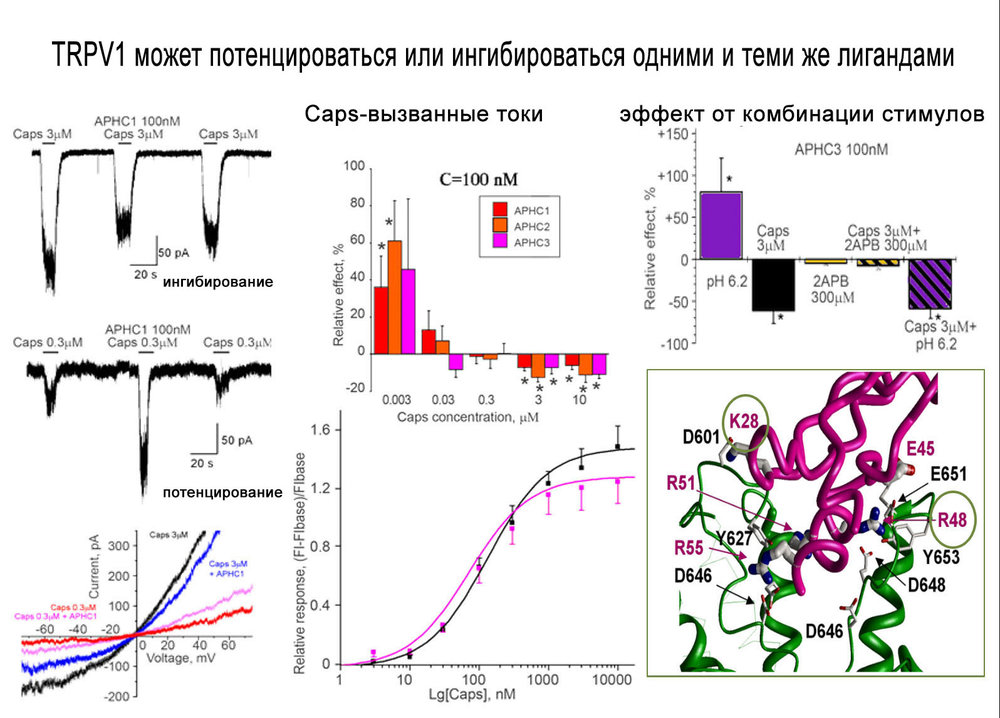
Изучено действие полипептидов APHC1, APHC2 и APHC3, ранее выделенных из морской анемоны Heteractis crispa, на рецепторы rTRPV1, экспрессированные в клетках CHO, с использованием методов электрофизиологии, флуоресцентной спектроскопии и молекулярного моделирования. Установлено, что APHCs потенцируют ответ TRPV1, вызванный низкими (3-300 нМ) концентрациями специфичного агониcта — капсаицина, и ингибируют ответы при высоких (>3.0 мкМ) концентрациях активатора. Были также найдены зависимости действия пептидов на TRPV1 при варьировании активаторов, таких как: 2APB и протоны, и на комбинированные активационные стимулы. В итоге, был установлен бимодальный механизм действия APHCs, зависящий от силы активируюшего стимула, — потенцирование малоамплитудных ответов рецептора и отсутствие эффекта/ингибирование высокоамплитудных ответов. Предложена двойная «шлюзовая» модель активации TRPV1, которая предполагает, что APHC-полипептиды могут стабилизировать промежуточное состояние во время активации рецептора. Методом молекулярного моделирования установлен предполагаемый сайт связывания пептидов между парами внешних P-петель TRPV1.
Модуляторы с дуалистическим эффектом могут иметь определенное преимущество с точки зрения их практического медицинского применения, такие соединения не тормозят нормальную работу рецептора, однако, в случае патологически сильной активации производят желаемый терапевтический эффект.
- 2017 TRPV1 activation power can switch an action mode for its polypeptide ligands. PLoS One 12 (5) e0177077
Лаборатория синтетических вакцин (Вольпина О.М.)
Синтетический фрагмент рецептора конечных продуктов гликозолирования предотвращает потерю памяти и защищает нейроны мозга у животных с экспериментально индуцированной формой болезни Альцгеймера.
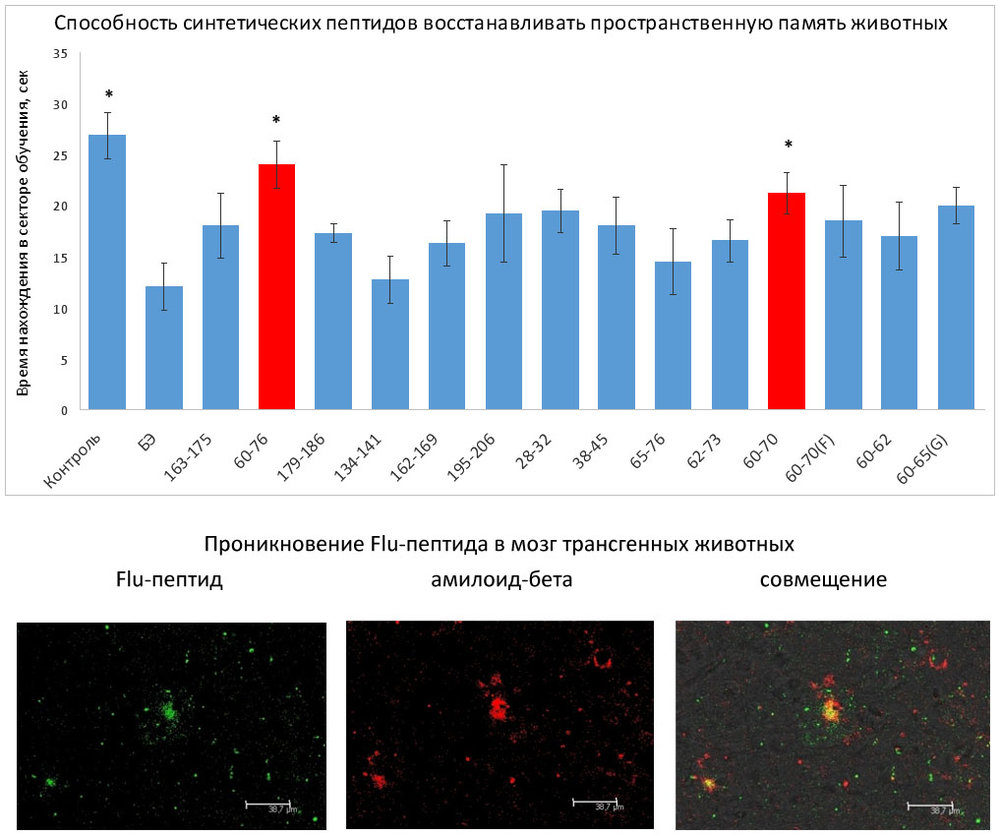
Установлена взаимосвязь между способностью пептидных фрагментов рецептора конечных продуктов гликозилирования предотвращать потерю памяти у животных с экспериментально индуцированной формой болезни Альцгеймера при интраназальном введении, при иммунизации и их способностью предотвращать гибель нейронов мозга и снижать уровень мозгового бета-амилоида. С помощью флуоресцентного производного активного пептида показано, что при интраназальном введении животным пептид проникает в мозг и солокализуется с бета-амилоидными бляшками. Установлено, что одной из молекулярных мишеней пептида является бета-амилоид. Эти данные являются основой для разработки новых средств терапии болезни Альцгеймера
- 2018 Synthetic Fragment of Receptor for Advanced Glycation End Products Prevents Memory Loss and Protects Brain Neurons in Olfactory Bulbectomized Mice. J Alzheimers Dis 61 (3) 1061–1076
- 2017 A synthetic fragment 60–70 of the receptor for advanced glycation end products exhibits a therapeutic effect in an animal model of Alzheimer’s disease. Russ. J. Bioorganic Chem. 43 (2) 150–154
Лаборатория молекулярных инструментов для нейробиологии (Василевский А.А.)
,Лаборатория биомолекулярной ЯМР-спектроскопии (Арсеньев А.С.)
Структура двудоменных токсинов пауков
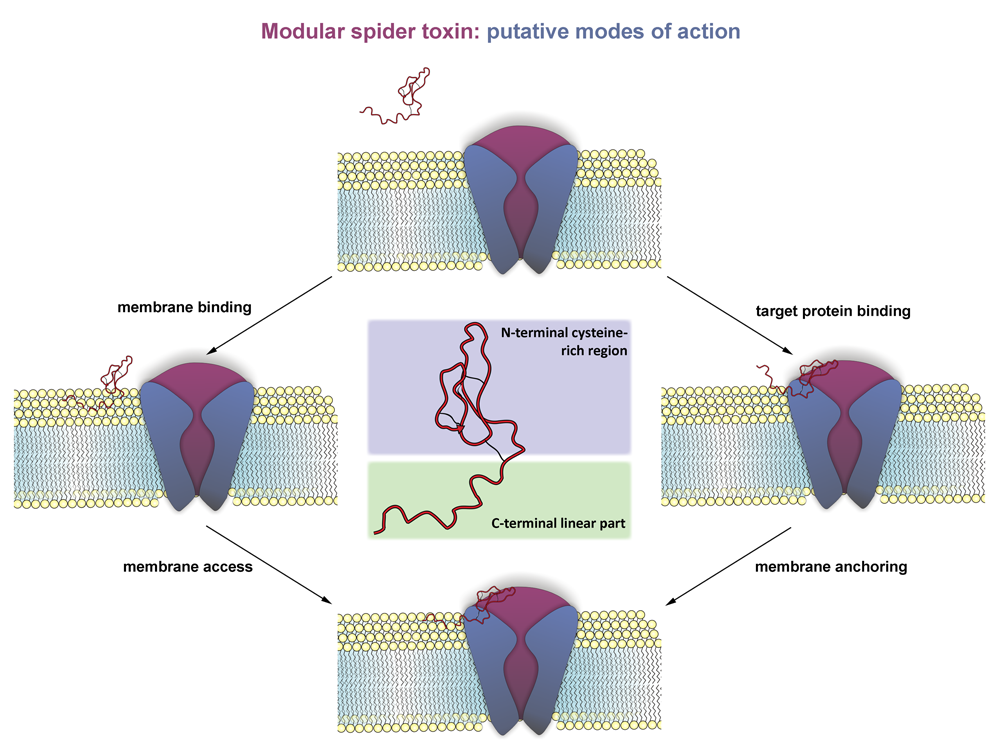
В яде многих пауков обнаружены двудоменные токсины, объединяющие в своей структуре модули, похожие на «простые» однодоменные токсины. Мы провели детальное структурное исследование тех токсинов, что состоят из дисульфид-богатых (похожих на обычные нейротоксины) и линейных (похожих на обычные цитотоксины) модулей. Линейные модули могут служить для ассоциации двудоменных токсинов с мембранами вследствие формирования амфифильных спиралей, характерных для мембрано-активных пептидов. Предложен механизм действия двудоменных токсинов по типу «мембранного доступа» (membrane access): линейные модули взаимодействуют с липидным бислоем, а дисульфид-богатые – с белковым рецептором.
- 2017 Modular toxin from the lynx spider Oxyopes takobius: Structure of spiderine domains in solution and membrane-mimicking environment. Protein Sci 26 (3) 611–616
- 2016 Structure of purotoxin-2 from Wolf spider: Modular design and membrane-Assisted mode of action in arachnid toxins. Biochem J 473 (19) 3113–3126
- 2016 Lachesana tarabaevi, an expert in membrane-Active toxins. Biochem J 473 (16) 2495–2506
- 2013 Spider toxins comprising disulfide-rich and linear amphipathic domains: A new class of molecules identified in the lynx spider Oxyopes takobius. FEBS J 280 (23) 6247–6261
- 2013 Cysteine-rich toxins from Lachesana tarabaevi spider venom with amphiphilic C-terminal segments. BIOCHIM BIOPHYS ACTA 1828 (2) 724–731
Отдел молекулярной биологии и биотехнологии растений
Лаборатория молекулярной диагностики (Завриев С.К.)
Субклеточная локализация и детекция белка ОРТ6 вируса табачной мозаики с помощью иммуноэлектронной микроскопии
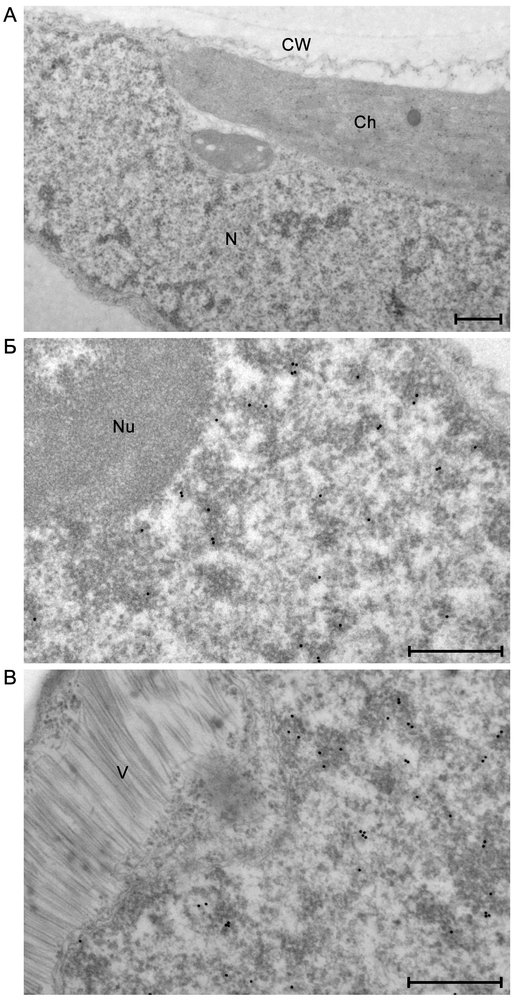
В предшествующих исследованиях было показано, что геномы ряда тобамовирусов в дополнение к генам белка оболочки, транспортного белка и цистрону, кодирующему различные домены РНК_полимеразы, содержат слабо консервативный короткий ген ОРТ6 . В данной работе с помощью биохимических и иммунологических методов было доказано, что в зараженных двумя изолятами вируса табачной мозаики (ВТМ, штамм U1) растениях действительно накапливается пептид ОРТ6. При этом в отличие от скоплений вирусных частиц, обнаруженных в цитоплазме клеток, продукт ОРТ6 выявлен в основном в ядрах, что соответствует ранее опубликованным данным по временной экспрессии изолированной ОРТ6 штамма U1. Кроме того, нами получены новые данные, подтверждающие существование генов OРТ6 в ви ромах целого ряда тобамовирусов.
- 2017 Subcellular localization and detection of Tobacco mosaic virus ORF6 protein by immunoelectron microscopy. Biochemistry (Mosc) 82 (1) 60–66
Лаборатория молекулярной диагностики (Завриев С.К.)
Получен ковалентный конъюгат ДНК-антитело для использования в иммуно-ПЦР

Конъюгат антитела и одноцепочечного олигонуклеотида был получен с использованием биоортогональной реакции азид-алкинового циклоприсоединения, промотируемого напряжением. Антитело модифицировали сульфотетрафторфениловым эфиром азидокапроновой кислоты; для модификации олигонуклеотида с введенной при синтезе аминогруппой использовали N-гидроксисукцинимидный эфир дибензоциклоактина. Получены конъюгаты со степенью меченья 1-3 олигонуклеотида на антитело.
Лаборатория молекулярной диагностики (Завриев С.К.)
Изучение экспрессии генов трихотеценового кластера у грибов Fusarium graminearum и F. ussurianum в различных условиях культивирования и их токсигенности

Была изучена динамика экспрессии генов трихотеценового кластера, включающего в себя 12 генов, ответственных за регуляцию и отдельные этапы биосинтеза микотоксинов. Для этого были выбраны токсигенных штаммы F. graminearum (Ст-6 и Ст-9) и F. ussurianum (g. 120 и g. 267). Продемонстрировано наличие 3-х групп генов, отличающихся друг от друга по уровням и временным параметрам экспрессии. Особое внимание нами было уделено двум генам, функциональное значение которых на сегодняшний день не вполне ясно –TRI9 и TRI14. Показано, что экспрессия этих двух генов сохранялась на низком уровне в течение всего процесса культивирования. Впервые расшифрованы нуклеотидные последовательности и определены вероятные структуры белков, кодируемых геном TRI14 у видов F. poae, F. sambucinum, F. langsethiae, F. venenatum, F. cerealis.
Лаборатория биотехнологии растений (Бурьянов Я.И.)
Биологическая активность экстракта цекропин Р1 экспрессирующих растений каланхоэ

В экспериментах на растениях и животных исследован водный экстракт полученных в лаборатории растений каланхоэ перистого (Kalanchoe pinnata L.), экспрессирующих ген антимикробного пептида цекропина P1 (сесР1). Экстракт эффективно индуцирует ризогенез у каллусов трудных для дифференцировки in vitro растений Mesembryanthemum crystallinum. Обнаружена высокая ранозаживляющая (рис. 1) и антимикробная активность экстракта сесР1-растений, превосходящая эффективность антибиотика цефазолина в отношение возбудителей гнойных инфекций Staphylococcus aureus и Pseudomonas aeruginosa (рис. 2) и противогрибкового препарата клотримазола в отношение высоковирулентного клинического изолята Candida albicans. Полученные результаты указывают на перспективность использования сесР1-растений каланхоэ в экспериментальной биологии и фармакологии.
- 2018 Biological Activity of Leaf Extracts from Cecropin P1-Synthesizing Kalanchoe Plants: Pharmacological Prospects. Russ J Plant Physiol 65 (1) 136–142
- 2017 Bactericide, immunomodulating, and wound healing properties of transgenic Kalanchoe pinnata synergize with antimicrobial peptide cecropin P1 in Vivo. J Immunol Res 2017 (0) 4645701
- 2017 Immunomodulating and Revascularizing Activity of Kalanchoe pinnata Synergize with Fungicide Activity of Biogenic Peptide Cecropin P1. J Immunol Res 2017 (0) 3940743
Группа лесной биотехнологии (Шестибратов К.А.)
Сорт березы пушистой (Betula pubescens Ehrh.) Белрос-3
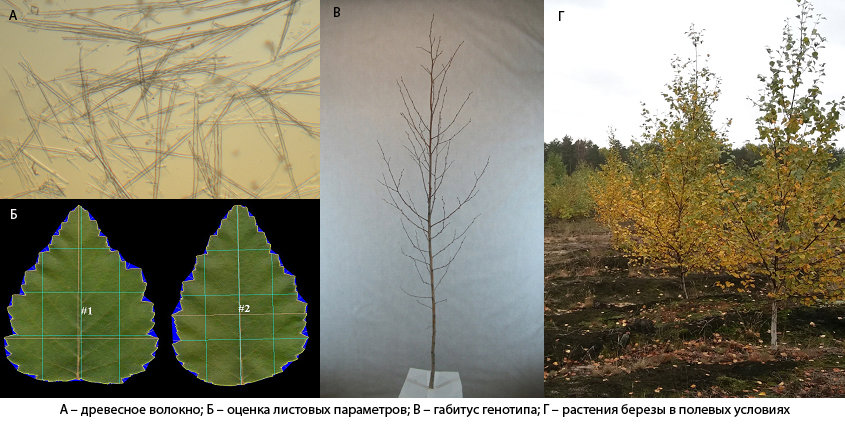
Береза является основной лесообразующей лиственной породой Российской Федерации, занимая 15% площади лесопокрытых земель. До настоящего времени в Государственном реестре селекционных достижений не зарегистрировано ни одного сорта березы. Впервые в России создан сорт березы пушистой, который отличается от неселекционных генотипов высокой стабильностью различных ростовых характеристик, повышенной продуктивностью и увеличенными размерами древесного волокна. Генотип может быть использован в плантационных насаждениях интенсивного типа.
Лаборатория молекулярных основ стрессоустойчивости растений (Тальянский М.Э.)
,Лаборатория экспрессионных систем и модификации генома растений «БИОТРОН» (Долгов С.В.)
Мегагрант Правительства Российской Федерации
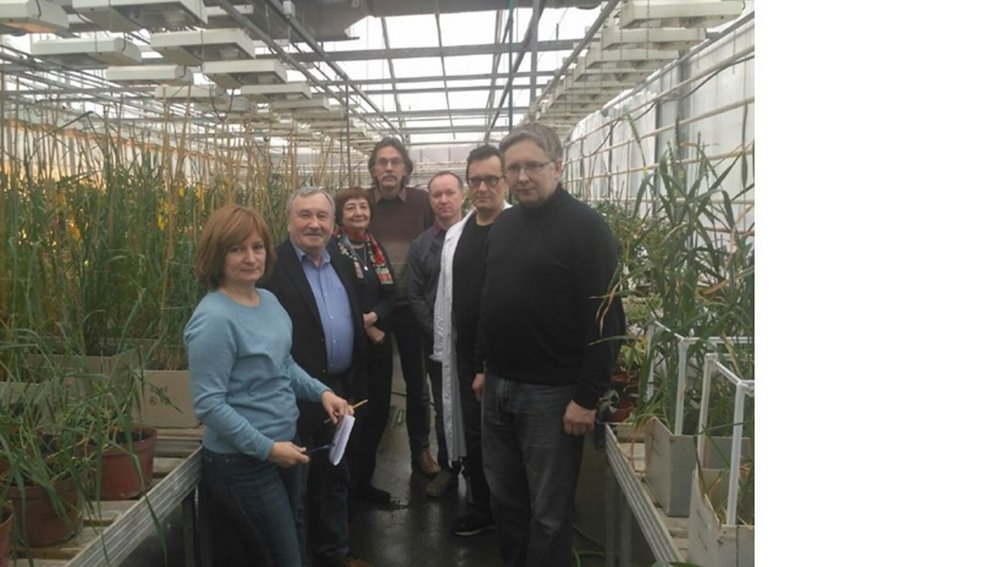
Лаборатория молекулярных основ стрессоустойчивости растений была создана в 2017 году, после получения профессором M. Тальянским мегагранта правительства РФ для проведения работ по теме:«Новые функции клеточного ядра и комплексная устойчивость растений картофеля к болезням и физиологическим стрессам». Деятельность лаборатории направлена на получение всесторонних знаний о механизмах комплексных стрессов в растениях и идентификацию ключевых целевых генов, необходимых для защиты растений от влияния различных стрессов на рост, развитие и продуктивность растений.
Отдел химической биологии гликанов и липидов
Лаборатория химии липидов (Водовозова Е.Л.)
,Лаборатория молекулярной токсинологии (Уткин Ю.Н.)
Новые флуоресцентные зонды для исследования строения и функций мембран
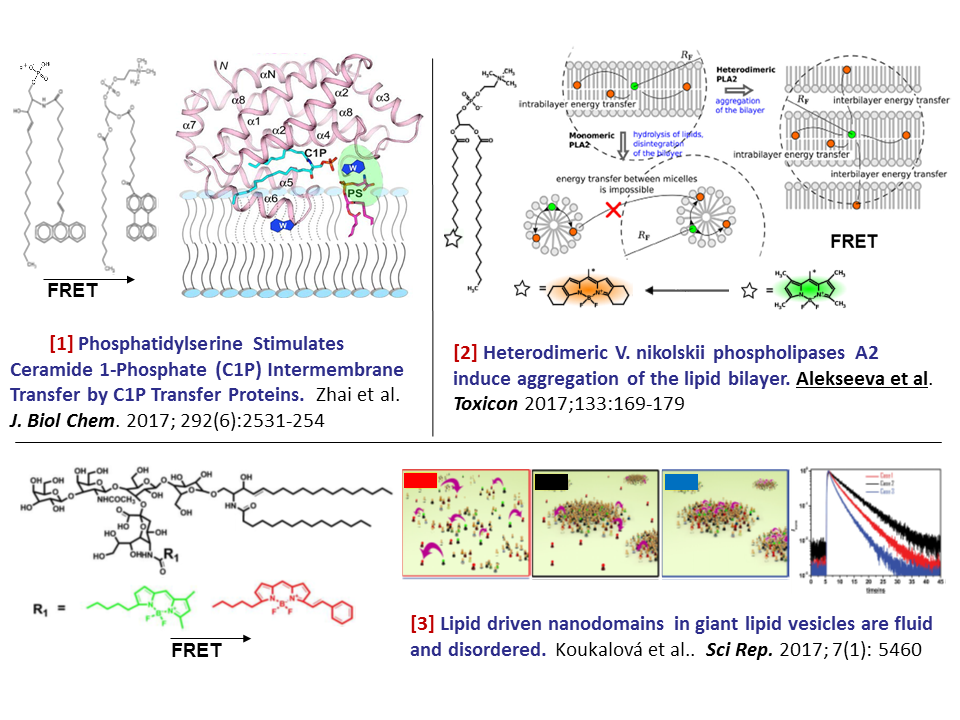
С помощью антрилвинил-периленоильной FRET-пары (FRET - Förster resonance energy transfer) фосфолипидных зондов показано, что на поверхности церамид-1-фосфат-переносящего белка существуют регуляторные центры взаимодействий с головными группами фосфоглицеридов в липидной мембране, в отличие от других представителей суперсемейства гликолипид-переносящих белков, специфичных к гликолипидам [1]. С помощью новой BODIPY FRET-пары фосфатидилхолиновых зондов показано, что действие гетеродимерных фосфолипаз А2 из яда гадюки Никольского на отрицательно заряженные липидные бислои приводит к агрегации и стэкингу мембран; это может являться одним из механизмов биологической активности фосфолиазы А2 [2]. Методом FRET между BODIPY-ганглиозидными зондами в сочетании с симуляцией Монте-Карло показано, что в модельных мембранах, имитирующих плазмалемму, образуются сфингомиелин-холестериновые 10-нм-домены (рафты) с жидкокристаллической неупорядоченной фазой [3].
- 2017 Heterodimeric V. nikolskii phospholipases A2 induce aggregation of the lipid bilayer. Toxicon 133 (0) 169–179
- 2017 Phosphatidylserine stimulates ceramide 1-phosphate (C1P) intermembrane transfer by C1P transfer proteins. J Biol Chem 292 (6) 2531–2541
- 2017 Lipid Driven Nanodomains in Giant Lipid Vesicles are Fluid and Disordered. Sci Rep 7 (1) 5460
Лаборатория химии липидов (Водовозова Е.Л.)
,Лаборатория биотехнологии (Мирошников А.И.)
Липосомы с липофильным пролекарством метотрексата: взаимодействия с опухолевыми клетками и исследования in vivo
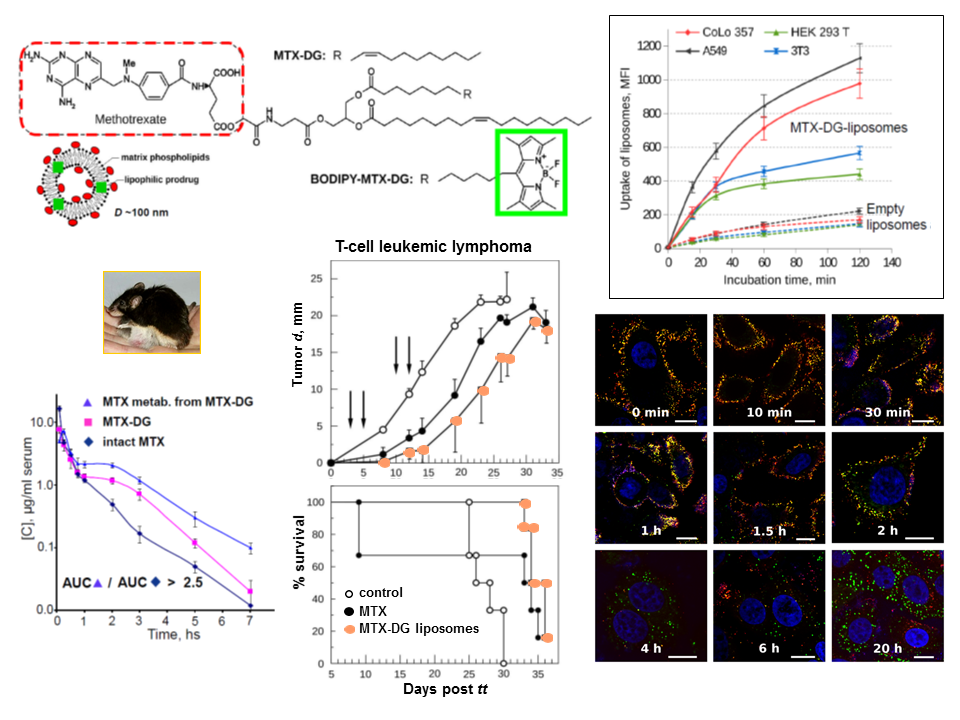
Ранее нами разработаны 100-нм-липосомы, несущие в липидном бислое широко используемый цитостатический агент метотрексат (МТХ) в виде диглицеридного эфира (MTX-DG, липофильное пролекарство). В данной работе изучены взаимодействия MTX-DG-липосом с опухолевыми клетками мыши и человека с помощью флуоресцентных методов. Липосомы содержали флуоресцентные аналоги фосфатидилхолина и MTX-DG. Клетки карциномы накапливали в 5 раз больше MTX-DG-липосом, чем липосом без пролекарства. С помощью ингибиторов эндоцитоза показано, что липосомы доставляют MTX-DG в клетку посредством нескольких механизмов. После связывания с клеткой липосомы остаются интактными 1.5-2 ч, затем сливаются с клеточной мембраной, и далее компоненты липосом раздельно интернализуются клеткой. По данным анализа содержания МТХ в плазме крови мышей в зависимости от времени, после i.v. введения MTX-DG-липосом величина AUC (площадь под кривой) для МТХ, метаболизировавшего из MTX-DG-липосом, превысила в 2.5 раза этот параметр, полученный после введения интактного МТХ. Результаты свидетельствуют о преимуществах применения липосомальной формы для лечения системных проявлений гематологических злокачественных заболеваний. Введение MTX-DG-липосом мышам с перевитой Т-клеточной лейкемической лимфомой в щадящем режиме (4 i.v. в низко-средней дозе) показало уменьшение токсичности и усиление ингибирования роста лимфомы по сравнению с МТХ.
- 2017 Liposomal formulation of a methotrexate lipophilic prodrug: Assessment in tumor cells and mouse T-cell leukemic lymphoma. Int J Nanomedicine 12 (0) 3735–3749
Отдел биоматериалов и бионанотехнологий
Лаборатория молекулярной биофизики (Олейников В.А.)
Уникальная научная установка «Система зондово-оптической 3D корреляционной микроскопии»

Разработана, сконструирована, изготовлена и включена в государственный реестр уникальных научных экспериментальных установок «Система зондово-оптической 3D корреляционной микроскопии».
Новый прибор предназначен для получения трехмерных изображений биологических и других объектов, реконструкции 3- D распределения различных физико-химических параметров по объему объекта, включая определение химического состава в локальных областях объекта с разрешением, соответствующем нанометровому диапазону.
Доступны все методы сканирующей зондовой микроскопи (контактный, полуконтактный, динамическая контактная (taping mode), атомно-,, магнитно-, электро-силовая микроскопия, Кельвин (Kelvin-mode) и сканирующая микроскопия распределения токов. Имеется также возможность использования конфокальной флуоресцентной спектроскопии, спектроскопии комбинационного рассеяния, включая (SERS и TERS) и сканирующая микроскопия ближнего поля (SNOM). Разрешение ультрамикротомографии – 20 нм. Инструмент включает программное обеспечение для реконструкции трехмерной реконструкции морфологической / оптической структуры образцов.
На рисунке показан внешний вид уникальной установки, схема действия и пример применения. В качестве домонстрации возможностей применения и получения 3-D информации об микрообъектах, определена «архитектура» магнитно-флуоресцентных микросфер для клинической диагностики и систем доставки лекарств, определенная с использование ультрамикротомографии, флуоресцентной микроспектроскопии и магнитно-силовой микроскопии.
- 2017 An instrumental approach to combining confocal microspectroscopy and 3D scanning probe nanotomography. Ultramicroscopy 182 (0) 118–123
- 2017 A novel design of a scanning probe microscope integrated with an ultramicrotome for serial block-face nanotomography. Rev Sci Instrum 88 (2) 023701
Лаборатория полимеров для биологии (Зубов В.П.)
Композиционный материал для рентгеноконтрастной визуализации нерентгеноконтрастных имплантатов.
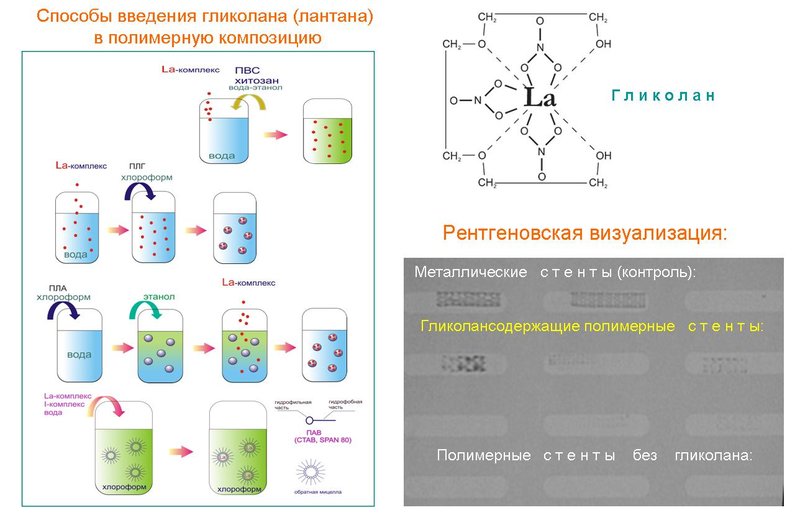
Разработаны биосовместимые биоразлагаемые полимерные покрытия на основе полимолочной кислоты с включенным гликоланом (или лантаном) для использования в составе полимерных биодеградируемых сосудистых стентов (и других полимерных имплантатов), что обеспечивает за счет условий включения удовлетворительную рентгеноконтрастность не только во время процедуры установки стента пациенту, но и после установки, и одновременно обеспечивает дополнительный положительный эффект за счет терапевтических свойств гликолана. Гликолан– комплексное соединение азотнокислого лантана и триэтиленгликоля – La (NO3) 3 • C6H14O4 • mH2O, обладет антимикробным действием.
- Генералова А.Н., Простякова А.И., Пашкин И.И., Зубов В.П., Капустин Д.В. Композиционный материал для рентгеноконтрастной визуализации нерентгеноконтрастных имплантатов. Патент РФ № 2599510 (15.09.2016).
Группа молекулярной экологии (Трубецкая О.Е.)
Трехмерные спектры флуоресценции как тест-система для оценки эффективности препаративного фракционирования гуминовых веществ различного генезиса

В последние годы для изучения сложных гетерогенных смесей, в том числе и природных гуминовых веществ, широкое применение получила трехмерная флуоресцентная спектроскопия, основанная на компьютерном анализе данных, полученных после снятия нескольких десятков спектров испускания одного и того же образца при различных длинах волн возбуждения заданного диапазона. Совокупность данных позволяет получать трехмерные флуоресцентные диаграммы с идентификацией всех возможных максимумов флуоресценции и их интенсивностей. Данный метод был освоен и впервые в России использован в качестве тест-системы для оценки эффективности фракционирования гуминовых веществ различного происхождения с целью выделения и идентификации индивидуальных флуорофоров и фотохимически активных компонентов. На рисунке представлены трехмерные флуоресцентные диаграммы исходного препарата растворенного органического вещества из реки Сувани и его фракций, полученных с помощью препаративной эксклюзивной хроматографии. Трехмерная флуоресцентная диаграмма позволяет не только оценить эффективность фракционирования, но и служит прямым подтверждением супрамолекулярной организации природных гуминовых веществ. Публикации: Trubetskoi O.A., Trubetskaya O.E. Three-dimensional fluorescence analysis of chernozem humic acids and their electrophoretic fractions. Eurasian Soil Science (2017) 50:1018-1024. (Перевод: Почвоведение 2017, № 9, с.1057-1064). DOI:10.7868/S0032180X17090088Трубецкой О.А., Трубецкая О.Е. Идентификация флуорофоров органического вещества природной воды. Водные ресурсы (2017) Принята к опубликованию.
Отдел геномики адаптивного иммунитета
Лаборатория методов иммуносеквенирования (Чудаков Д.М.)
Достижения 2017
Исследование репертуаров Т-клеточных рецепторов и антител в норме и патологии
Лаборатория сравнительной и функциональной геномики (Лебедев Ю.Б.)
Характеристика Т-клеточного иммунного ответа на противогриппозную вакцинацию

С целью изучения Т-клеточного иммунного ответа на тривалентную субъединичную гриппозную вакцину «Инфлювак» проведен глубокий профайлинг репертуара Т-клеточных рецепторов в периферической крови вакцинируемого донора. Выяснено, что гриппозная вакцина не вызывает значительного реформирования клонального репертуара периферических Т-лимфоцитов. Вместе с тем, обнаружено формирование новой субпопуляции Т-клеток памяти, которая характеризуется максимальной клональной экспансией на 45 день после вакцинации и резким снижением представленности в репертуаре через 2 года наблюдений. Предположено, что данная олигоклональная субпопуляция Т-клеток может, после ее активации при сезонных прививках, участвовать в противовирусной защите организма.
- Sycheva A.L., Pogorelyy M.V., Minervina A.A., Komech E.A., Zvyagin I.V., Staroverov D.B., Chudakov D.M., Lebedev Y.B., Mamedov I.Z. Quantitative profiling reveals minor changes of T cell receptor repertoire in response to subunit inactivated influenza vaccine. Vaccine, 2017 (under review)
Отдел функционирования живых систем
Лаборатория механизмов генной экспрессии (Шпаковский Г.В.)
Прогестерон как древнейший биорегулятор растительной клетки
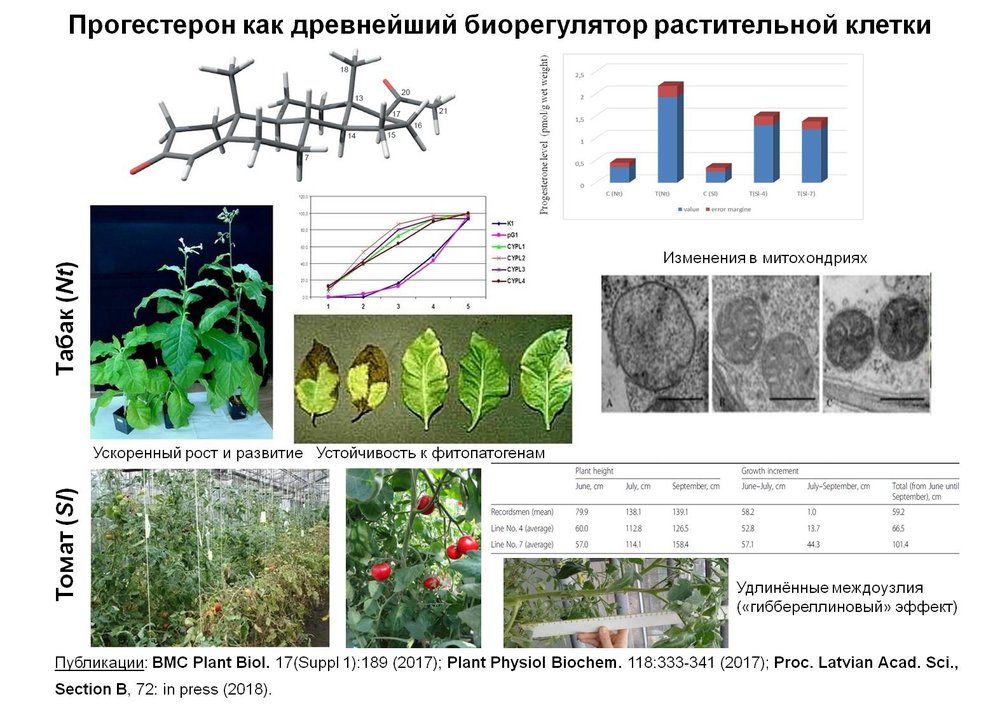
Впервые продемонстрирована совместимость in vivo даже самых специфичных компонентов систем биосинтеза стероидных гормонов растений и животных. Путём повышения уровня эндогенного прогестерона в специально сконструированных для этих целей трансгенных растениях табака и томата со встройками кДНК CYP11A1 животных, мы смогли существенно ускорить процессы роста и развития растений и повысить их устойчивость к абиотическим и биотическим стрессам. Формирование вышеупомянутых успешных (желаемых) фенотипов у полученных трансгенных растений семейства Паслёновые, экспрессирующих кДНК цитохрома P450scc (CYP11A1) млекопитающих, подразумевает, что прогестерон можно считать очень древним биорегулятором растительных клеток и, пожалуй, первым настоящим гормонов, общим для растений и животных. Полученные результаты свидетельствуют об определённом сходстве путей биосинтеза стероидных соединений и систем стероидного регулирования у растений и животных и могут быть использованы в новых биотехнологиях для сельского хозяйства и фармакологии.
Лаборатория механизмов генной экспрессии (Шпаковский Г.В.)
Новые нуклеотидные модификации для стабилизации канонических и неканонических вторичных структур нуклеиновых кислот
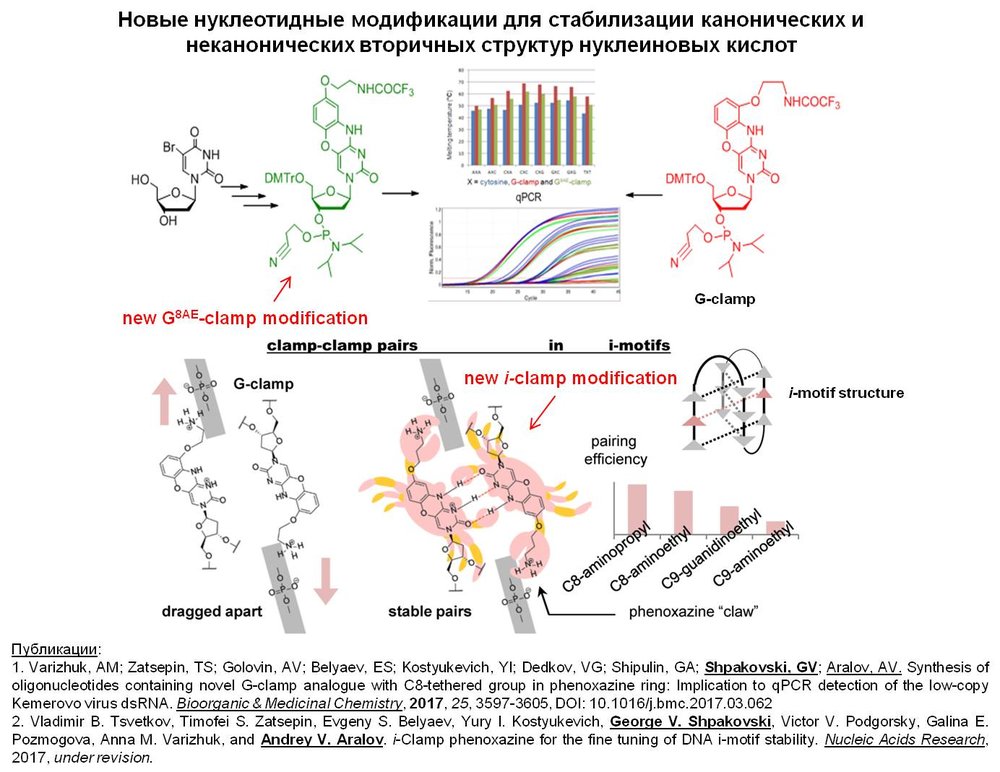
Разработаны новые феноксазиновые нуклеотидные модификации для стабилизации канонических (G8AE-clamp) и неканонических (i-Clamp) вторичных структур нуклеиновых кислот (НК). Введение G8AE-clamp обеспечивает превосходную стабилизацию дуплексных структур НК, а использование праймеров с данной модификацией вместо немодифицированных олигонуклеотидов приводит к значительному повышению чувствительности детекции дцРНК вируса Кемерово в природных изолятах с помощью кПЦР. На настоящий момент, i-clamp модификация показывает наилучшие стабилизирующие i-мотив (iM) свойства в широком диапазоне кислых pH и может быть использована для конструирования iM-наноустройств с заранее заданными свойствами, таких как pH сенсоры, молекулярные моторы, гидрогели, конструкции для доставки лекарственных средств и т.д.
Лаборатория мембранных и биоэнергетических систем (Шахпаронов М.И.)
,Группа кросс-сшивающих ферментов (Пестов Н.Б.)
Определение роли белков-регуляторов сплайсинга в межклеточной коммуникации опухолевых клеток
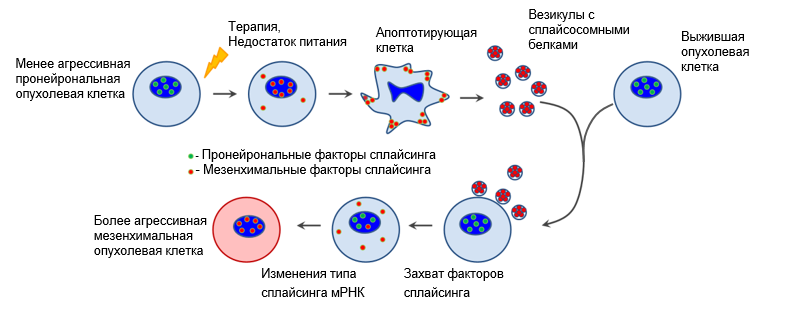
Продемонстрирован новый механизм коммуникации опухолевых клеток, основанный на межклеточном транспорте сплайсосом. Исследуя клинические образцы от пациентов с раком яичника, а также первичные культуры клеток глиобластомы человека, мы обнаружили, что при индукции апоптоза опухолевые клетки способны секретировать во внешнюю среду разнообразные компоненты сплайсосомы, рибонуклеопротеидного комплекса, осуществляющего сплайсинг молекул РНК в эукариотических клетках. Мы показали, что на ранних стадиях апоптоза сплайсосомы перемещаются из ядра в цитоплазму, а затем экспортируются из клетки в виде мембранных везикул (экзосом). Эти везикулы захватываются соседними опухолевыми клетками, а сплайсосомные белки, содержащиеся в них, изменяют тип сплайсинга мРНК в реципиентных клетках. Всё это приводит к появлению иных изоформ белков и приобретению клеткой, поглотившей везикулы, более агрессивного и устойчивого к терапии фенотипа. В качестве одного из ключевых участников описанного выше процесса нами был определён белок RBM11, который передаётся между клетками и регулирует сплайсинг таких важных онкогенов как MDM4 и CyclinD1.
Отдел «Учебно-научный центр» (Овчинникова Т.В.)
Димеризация β-шпилечных антимикробных пептидов играет ключевую роль в проявлении цитотоксичности, но не антимикробной активности
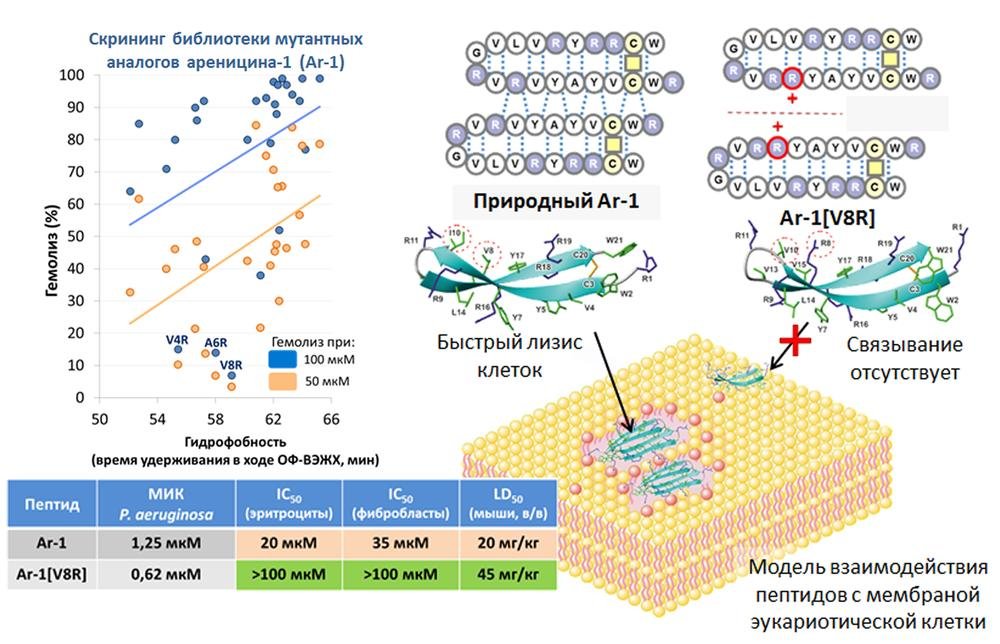
Антимикробные пептиды ареницины были обнаружены нами ранее в целомоцитах морского кольчатого червя пескожила Arenicola marina. В 2017 г. исследована взаимосвязь структуры аналогов β-шпилечного антимикробного пептида ареницина-1 и их биологической активности с целью поиска подходов, позволяющих снизить цитотоксичность природного пептида и создать терапевтически ценные препараты. Для этого с использованием методов сайт-направленного мутагенеза и гетерологической экспрессии в бактериальной системе был создан широкий спектр аналогов ареницина-1 (более 50 пептидов), различающихся по гидрофобности, суммарному заряду, длине цепи. Полученные данные указывают на то, что переход пептида в форму димера, а не его высокая гидрофобность является ключевым фактором, обуславливающим проявление цитотоксических свойств природным пептидом. Выраженная бактерицидная активность в отношении патогенных бактерий, в том числе, мультирезистентных штаммов, а также высокий терапевтический индекс позволяют рассматривать сконструированные аналоги ареницина в качестве перспективных прототипов антибиотиков нового поколения с широким спектром действия.
- 2017 Dimerization of the antimicrobial peptide arenicin plays a key role in the cytotoxicity but not in the antibacterial activity. Biochem Biophys Res Commun 482 (4) 1320–1326
- 2017 A therapeutic potential of animal β-hairpin Antimicrobial Peptides. Curr Med Chem 24 (17) 1724–1746
- 2016 Bioengineering and functional characterization of arenicin shortened analogs with enhanced antibacterial activity and cell selectivity. J Pept Sci 22 (2) 82–91
- 2015 Design of antimicrobial peptide arenicin analogs with improved therapeutic indices. J Pept Sci 21 (2) 105–113
Отдел «Учебно-научный центр» (Овчинникова Т.В.)
,Лаборатория биомолекулярной ЯМР-спектроскопии (Арсеньев А.С.)
,Группа структурной биологии ионных каналов (Шенкарёв З.О.)
Раскрыт механизм связывания и переноса липидов растительными липид-транспортирующими белками
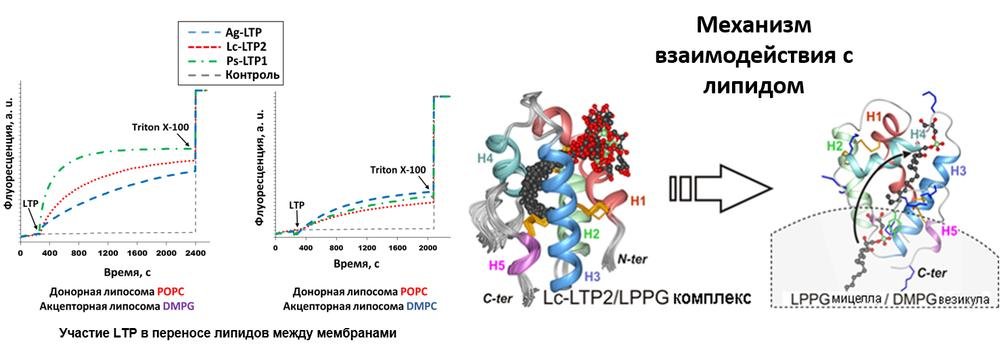
Новые липид-транспортирующие белки (LTP) чечевицы, гороха и укропа были выделены и охарактеризованы в Учебно-научном центре ранее. В 2017 г. нами показана способность растительных LTP с различной эффективностью связывать и переносить широкий спектр липидных молекул. Установлено, что аффинность LTP по отношению к насыщенным и ненасыщенным жирным кислотам возрастает по мере уменьшения длины ацильных цепей. Показано, что LTP эффективнее переносят анионный липид DMPG, чем цвиттерионный DMPC. Методами ЯМР-спектроскопии подтверждена более высокая аффинность LTP к анионным липидам и молекулам с небольшим размером гидрофобных цепей. Определена пространственная структура комплекса Lc-LTP2/LPPG. Установлено, что размер внутренней гидрофобной полости LTP увеличивается от 600 до 1000 А3 при связывании с липидами. Ацильные цепи LPPG или DMPG занимают пространство гидрофобной полости LTP, а головки липидов выступают наружу между α–спиральными участками Н1 и Н3. Другой вход в гидрофобную полость Lc-LTP2, ограниченный петлей между α–спиралями H2-H3 и С-концевым участком, играет важную роль во взаимодействии с поверхностью мембраны, участвует в поглощении липидов и определяет селективность LTP по отношению к лиганду. Полученные результаты впервые раскрывают механизм связывания и переноса липидов посредством LTP и углубляют понимание биологической роли растительных LTP.
- 2017 Ligand Binding Properties of the Lentil Lipid Transfer Protein: Molecular Insight into the Possible Mechanism of Lipid Uptake. Biochemistry 56 (12) 1785–1796
- 2017 Plant pathogenesis-related proteins PR-10 and PR-14 as components of innate immunity system and ubiquitous allergens. Curr Med Chem 24 (17) 1772–1787
- 2016 A novel lipid transfer protein from the pea Pisum sativum: Isolation, recombinant expression, solution structure, antifungal activity, lipid binding, and allergenic roperties. BMC Plant Biol 16 (1) 107
- 2016 Lipid Transfer Proteins As Components of the Plant Innate Immune System: Structure, Functions, and Applications. Acta Naturae 8 (2) 47–61
- 2016 A novel lipid transfer protein from the dill Anethum graveolens L.: Isolation, structure, heterologous expression, and functional characteristics. J Pept Sci 22 (1) 59–66
Группа генно-инженерных биофармацевтических технологий (Есипов Р.С.)
Разработка способов получения аналогов тимозина-бета 4 в виде коньюгатов с увеличенным временем жизни in vivo
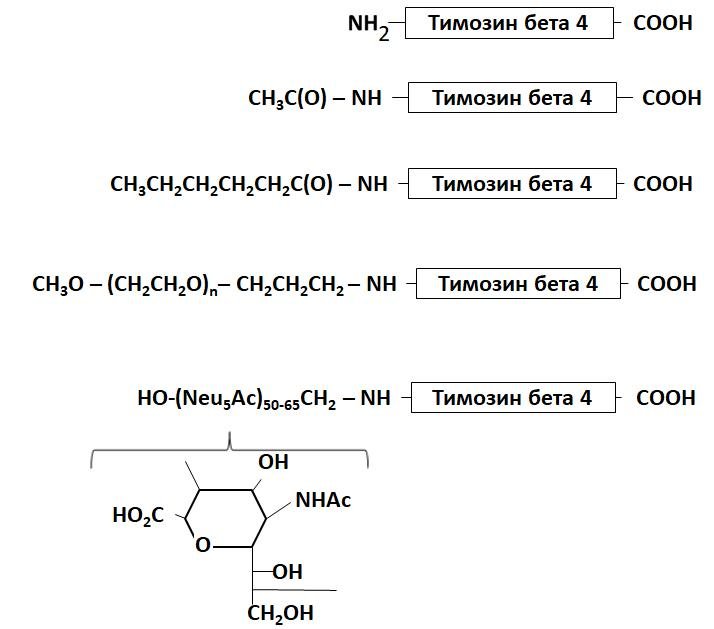
Разработан способ получения моноконъюгатов рекомбинантного тимозин-бета 4 (Тβ4) человека с капроновой кислотой, полисиаловой кислотой 14 кДа и полиэтиленгликолем 10 кДа. В результате многофакторных экспериментов были определены компоненты реакционной смеси и оптимизированы условия проведения данных реакций. Для каждого из аналогов разработана схема одностадийной очистки с помощью ОФ-ВЭЖХ, гарантирующая достижение не менее 98% хроматографической чистоты. Результаты пептидного картирования в совокупности с хромато-масс-спектрометрическим и электрофоретическим методами анализа показали, что полученные аналоги тимозин-бета 4 являются моноконъюгатами, в которых исходный пептид модифицирован по N-концевому серину. Полученные аналоги обладают повышенной устойчивостью к деградации в плазме крови по сравнению с немодифицированным тимозином бета 4 и могут рассматриваться как перспективные кандидаты для дальнейших биологических испытаний.
- 2016 Разработка способов получения аналогов тимозин-бета 4 в виде коньюгатов, устойчивых к деградации в токе крови. 32 (2) 57–71
Лаборатория молекулярных основ эмбриогенеза (Зарайский А.Г.)
Обнаружение и изучение функции гомебоксного гена Anf/Hesx1 у миног подтверждает его ключевую роль в появлении конечного мозга у позвоночных
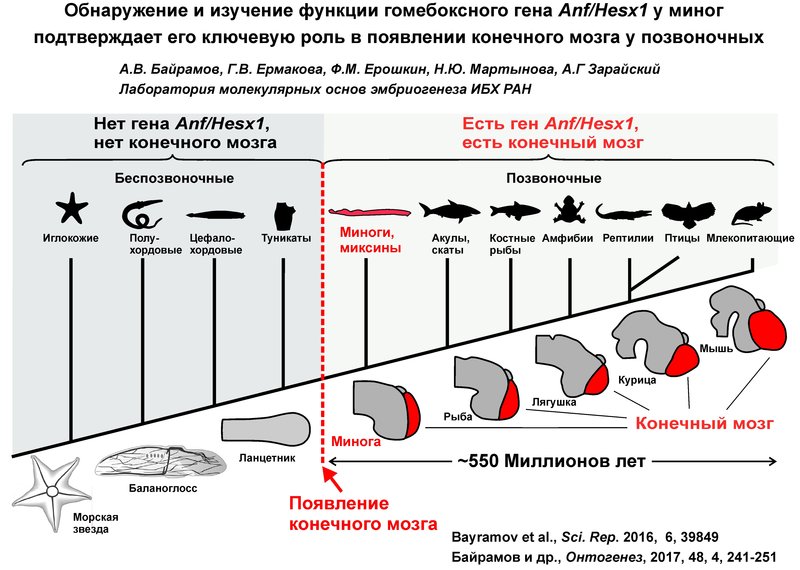
Важной особенностью позвоночных животных, в том числе человека, является уникальный отдел головного мозга, называемый теленцефалон, или конечный мозг, не имеющий гомологов у беспозвоночных. В состав тельэнцефалона входят, например, такие важнейшие структуры как большие полушария головного мозга. Ранее нами был открыт моногенный класс гомеобоксных генов Anf/Hesx1, также отсутствующий у всех беспозвоночных и играющий ключевую роль в регуляции развития теленцефалона у позвоночных. Однако, до недавнего времени ген Anf/Hesx1не был обнаружен у представителей самой древней группы позвоночных – у бесчелюстных рыб (современные миноги и миксины), при том что тельэнцефалон у этих животных был описан, а геномы отсеквенированы. Нами впервые установлено, что Anf/Hesx1, все-таки, присутствует и у миног, и показано, что у них он так же регулирует развитие тельэнцефалона. Полученные данные подтверждают выдвинутую нами ранее гипотезу о том, что возникновение теленцефалона в эволюции было связано с появлением гомеобоксного гена Anf/Hesx1.
- 2016 The presence of Anf/Hesx1 homeobox gene in lampreys suggests that it could play an important role in emergence of telencephalon. Sci Rep 6 (0) 39849
Отдел биоинженерии (ФИБХ)
Лаборатория химии белка (Липкин В.М.)
,Лаборатория белков гормональной регуляции (Липкин В.М.)
,Группа химии пептидов (Азев В.Н.)
,Лаборатория биологических испытаний (Мурашев А.Н.)
Разработка лекарственных средств пептидной природы для лечения рассеянного склероза
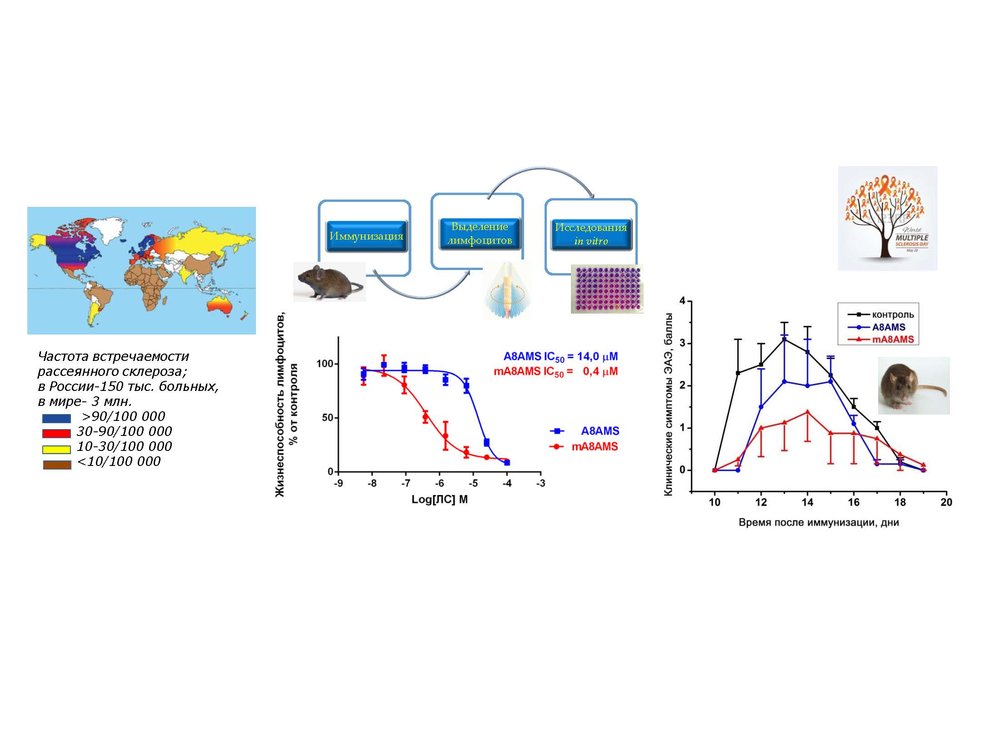
Рассеянный склероз – хроническое аутоиммунное заболевание с неврологической патологией. Доминирующая роль иммунологических процессов в развитии болезни диктует необходимость лекарственные средства, позволяющих специфически минимизировать активность иммунных процессов. Обнаружено, что пептиды A8AMS и mA8AMS, гомологичные фрагменту домена IgG VH человека, проявляют активность in vitro и in vivo, эффективно уменьшая симптомы развития экспериментального аутоиммунного энцефаломиелита, животной модели рассеянного склероза. Полученные результаты открывают новые возможности для разработки лекарственных средств пептидной природы для лечения рассеянного склероза.
1. Туробов В.И., Данилкович А. В. Шевелев А. В., Бирюкова Ю. К., Азев В. Н., Мурашев А. Н., Липкин В. М., Удовиченко И. П. Пептид из состава тяжелой цепи иммуноглобулина человека, пригодный для лечения рассеянного склероза. 2016. Заявка на патент РФ №2016151603
2. Туробов В.И., Данилкович А.В., Шевелев А.Б., Бирюкова Ю.К., Позднякова Н.В., Мустаева Л.Г., Горбунова Е.Ю., Байдакова Л.К., Полякова А.И., Азев В.Н., Мурашев А.Н., Липкин В.М., Удовиченко И.П. АКТГ-подобный пептид с иммуносупресорной функцией. 2017. Заявка на патент РФ №2017140866
Лаборатория пептидных биорегуляторов (Наволоцкая Е.В.)
,Лаборатория белков гормональной регуляции (Липкин В.М.)
,Лаборатория химии белка (Липкин В.М.)
Молекулярный механизм неопиоидного действия бета-эндорфина
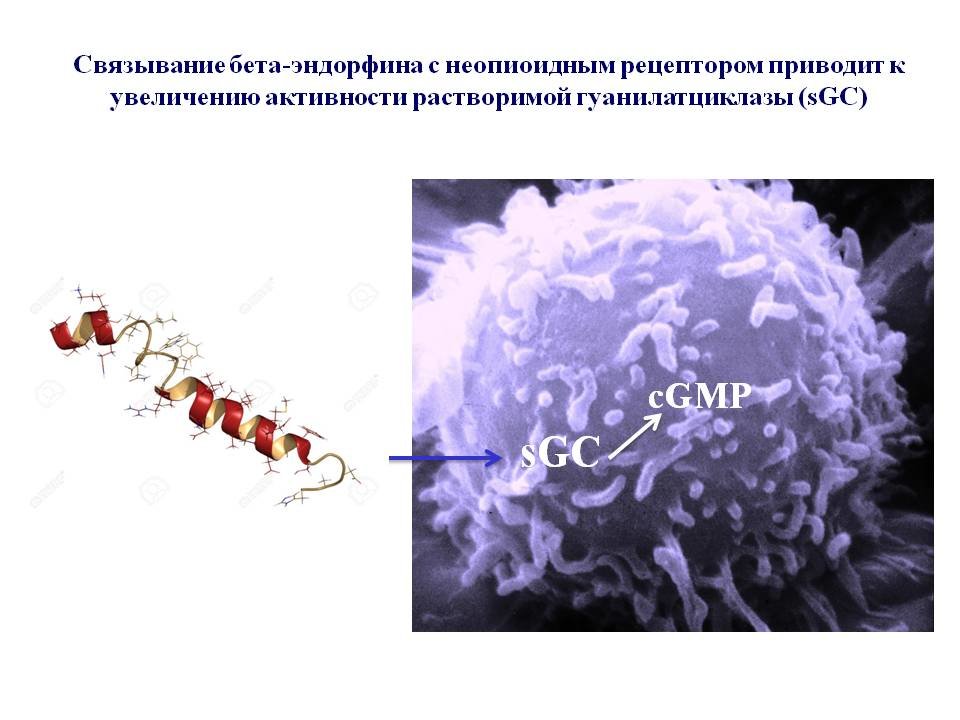
С помощью синтетического пептида октарфина (TPLVTLFK), селективного агониста неопиоидного рецептора бета-эндорфина, получены данные о молекулярном механизме неопиоидного действия гормона. Установлено, что неопиоидное действие бета эндорфина на клетку-мишень реализуется следующим путем: увеличение экспрессии индуцибельной NO-синтазы → возрастание продукции NO → увеличение активности растворимой гуанилатциклазы → возрастание внутриклеточного уровня cGMP.
- 2016 The synthetic peptide octarphin activates soluble guanylate. cyclase in macrophages. 42 (3) 269–271
- 2015 Octarphin--Nonopioid Peptide of the Opioid Origin. Bioorg Khim 41 (5) 524–530
- 2017 Synthetic Peptide TPLVTLFK, a Selective Agonist of Nonopioid β-Endorphin Receptor, Reduces the Corticotropin and Corticosterone Response. Int J Pept Res Ther 23 (1) 111–118
- 2016 Синтетический пептид октарфин активирует растворимую гуанилатциклазу макрофагов. 42 (3) 301–304
НПП «Питомник лабораторных животных» (Телегин Г.Б.)
Проектирование и разработка, разведение, содержание и поставка мелких лабораторных грызунов SPF категории в соответствии с международными требованиями AAALACi и ISO
Совет по аккредитации AAALAC International сообщает, что программа Питомника лабораторных животных ФИБХ РАН, соответствует стандартам AAALAC International, изложенным в Руководстве по содержанию и использованию лабораторных животных (the Guide for the Care and Use of Laboratory Animals, NRC 2011), и подтверждает статус ПОЛНОЙ АККРЕДИТАЦИИ на дальнейший период. Совет отметил энтузиазм курирующего ветврача и сотрудников, которые открыто отвечали на вопросы и сообщали полезную информацию, а также высокий уровень техобслуживания объекта и хорошие показатели деятельности по поддержанию благополучия животных.
Система менеджмента производства мелких лабораторных грызунов SPF-категории также успешно ресертифицирована компанией SGS United Kingdom Ltd, как отвечающая требованиям стандарта ISO 9001:2008.
25 декабря 2017 года

